User manual
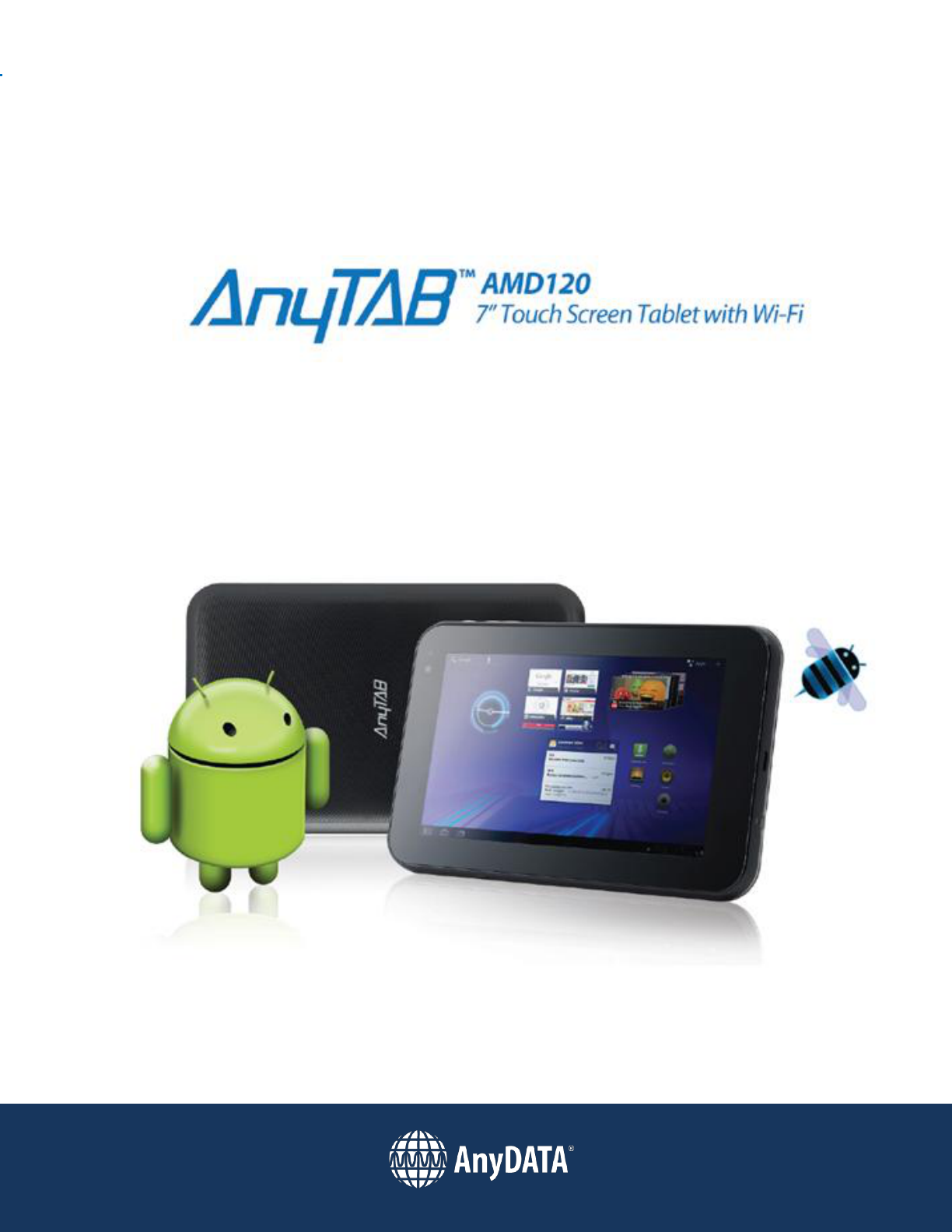
1

2
Compliance Information
FCC Notice
The following statement applies to all products that have received FCC approval.
Applicable products bear the FCC logo, and/or an FCC ID in the format FCC ID: P4M-AMD120 on the product label.
The mobile device complies with part of 15 of the FCC rules. Operation is subject to the following two conditions:
(1) This mobile device may not cause harmful interference, and (2) this mobile device must accept any interference
received, including interference that may cause undesirable operation. This mobile device has been tested and
found to comply with the limits for a Class B digital device, pursuant to Part 15 of the FCC Rules. These limits are
designed to provide reasonable protection against harmful interference in a residential installation. The
equipment generates uses and can radiate radio frequency energy and, if not installed and used in accordance
with the instructions, may cause harmful interference to radio communications. However, there is no guarantee
that interference will not occur in a particular installation. If this equipment does cause harmful interference to
radio or television reception, which can be determined by turning the equipment off and on, the user is
encouraged to try to correct the interference by one or more of the following measures
Reorient or relocate the receiving antenna.
Increase the separation between the equipment and receiver.
Connect the equipment into an outlet on a circuit different from that to which the receiver is connected.
Consult the dealer or an experienced radio/TV technician for help.
Changes or modifications not expressly approved by the party responsible for compliance could void the user’s
authority to operate the equipment.
The Antenna(s) used for this transmitter must not be collocated or operating in conjunction with any other
antenna or transmitter.
RF Exposure Information (FCC SAR)
DEVICE MEETS THE GOVERNMENT’S REQUIREMENTS FOR EXPOSURE TO RADIO WAVES. This device is designed
and manufactured not to exceed the emission limits for exposure to radio frequency (RF) energy set by the Federal
Communications Commission of the U.S. Governments.
The exposure standard for wireless mobile devices employees a unit of measurement known as the Specific
Absorption Rage, or SAR. The SAR limit set by the FCC is 1.6W/kg. Test for SAR are conducted using standard
operating positions accepted by the FCC with the device transmitting at its highest certified power level in all
tested frequency bands. Although the SAR is determined at the highest certified power level, the actual SAR level
of the device while operating cane be well below the maximum value. This is because the device is designed to
operate at multiple power levels so as to use only the poser required to reach the network. In general, the closer
you are to a wireless base station antenna, the lower the power output. The highest SAR value for the device as
reported to the FCC when tested for use when worn on the body, as described in this guide, is 0.657W/kg (Body-
worn measurements differ among device models, depending upon available accessories and FCC requirements.)
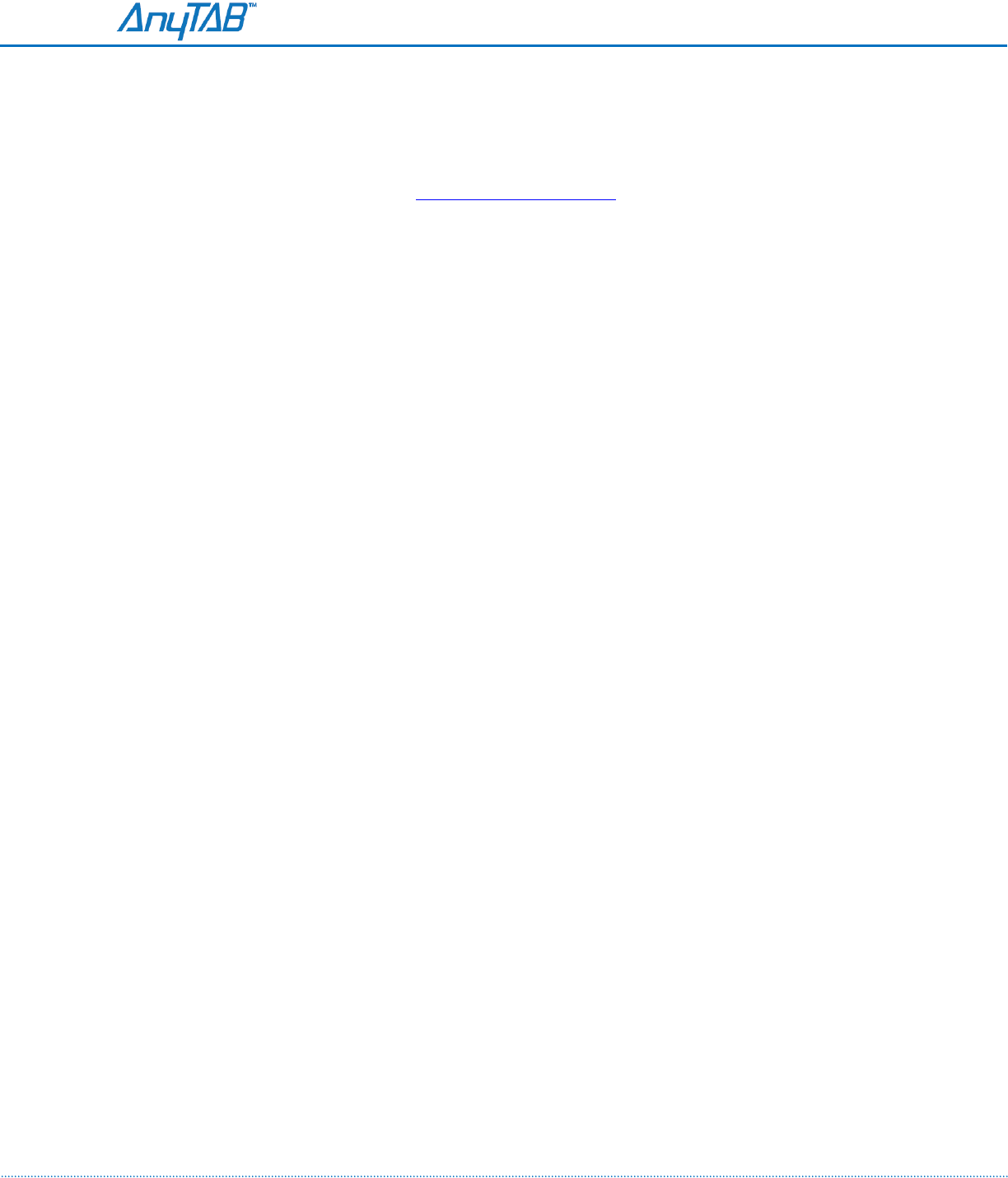
3
While there may be difference between the SAR levels of various devices and at various positions, they all meet
the government requirement.
The FCC has granted an Equipment Authorization for this device with all reported SAR levels evaluated as in
compliance with the FCC RF exposure guidelines. SAR information on this device is on file with the FCC and can be
found under the Display Grant Section of www.fcc.gov/oet/ea/fccid/ after searching on FCC ID: P4M-AMD120

4
Contents
What’s in the Box............................................................................................................................................ 6
Before Getting Started ................................................................................................................................... 6
Charging the Battery ....................................................................................................................................... 7
Welcome to Android ...................................................................................................................................... 9
Setting your location preferences .................................................................................................................. 9
Signing into your Google account ................................................................................................................. 10
Home and Android basics ............................................................................................................................. 11
Using the Touchscreen ................................................................................................................................. 12
Monitoring your Tablet’s status ................................................................................................................... 13
Status Icons ................................................................................................................................................... 13
Notification Icons ......................................................................................................................................... 13
Working with Quick settings ......................................................................................................................... 14
Securing your tablet ..................................................................................................................................... 15
Encrypt your tablet ....................................................................................................................................... 15
Customizing the Homescreen ....................................................................................................................... 16
Changing Homescreen Wallpaper ................................................................................................................ 16
Working with Apps ....................................................................................................................................... 17
Uninstall an App............................................................................................................................................ 17
Working with Widgets .................................................................................................................................. 18
Searching your tablet and the web ............................................................................................................. 19
Using the Android keyboard ......................................................................................................................... 20
Enter text by speaking .................................................................................................................................. 20
Connecting to Networks and Devices ........................................................................................................... 20
Connecting to WiFi Networks ...................................................................................................................... 21
Turn WiFi on and Connect to a Network ..................................................................................................... 22
Modify how you connect to a WiFi Network ............................................................................................... 22
Add a WiFi Network ...................................................................................................................................... 23
Forget a WiFi Network .................................................................................................................................. 23
Set a Wi-Fi disconnect policy ........................................................................................................................ 23
Connecting to Bluetooth devices ................................................................................................................. 24

5
Changing your tablet’s Bluetooth name: ..................................................................................................... 24
Pairing your tablet with a Bluetooth device: ................................................................................................ 25
Connect to a Bluetooth device: .................................................................................................................... 25
Connect to a Camera: ................................................................................................................................... 26
Connecting to a Windows computer via USB ............................................................................................... 26
Connecting to a Macintosh computer via USB ............................................................................................. 27
Optimizing battery life .................................................................................................................................. 27
Accounts ....................................................................................................................................................... 28
Contact
s
........................................................................................................................................................ 29
Connecting quickly with your contacts ........................................................................................................ 30
Gmail ............................................................................................................................................................. 31
Calendar ........................................................................................................................................................ 32
Google Talk ................................................................................................................................................... 33
Email ............................................................................................................................................................. 34
Browser ......................................................................................................................................................... 35
Maps, Navigation, Places, and Latitude ....................................................................................................... 36
Camera .......................................................................................................................................................... 36
Gallery ........................................................................................................................................................... 36
Movie Studio ................................................................................................................................................. 36
Music............................................................................................................................................................. 37
Opening Music and working with your library ............................................................................................. 38
Playing Music ................................................................................................................................................ 39
Books ............................................................................................................................................................ 39
Clock.............................................................................................................................................................. 40
Calculator ...................................................................................................................................................... 40
Market .......................................................................................................................................................... 41
Settings ......................................................................................................................................................... 41
Accessibility settings ..................................................................................................................................... 49
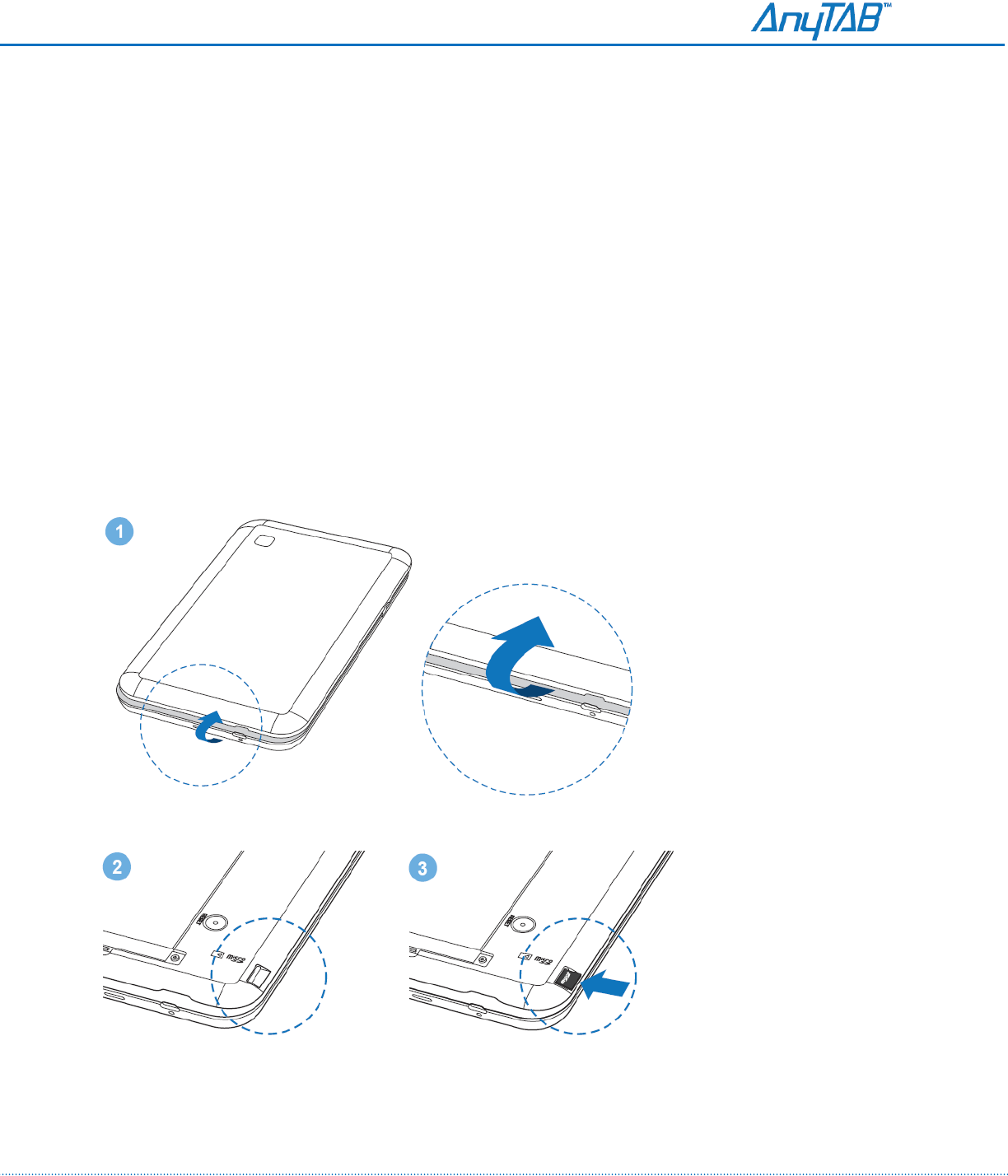
6
What’s in the Box
Your device box contains the following items:
Device with battery
Charger
USB cable
Quick start guide
Warranty card/Repair policy
Before Getting Started
Installing the micro SD Card
Using both thumbs, slide the back cover upward
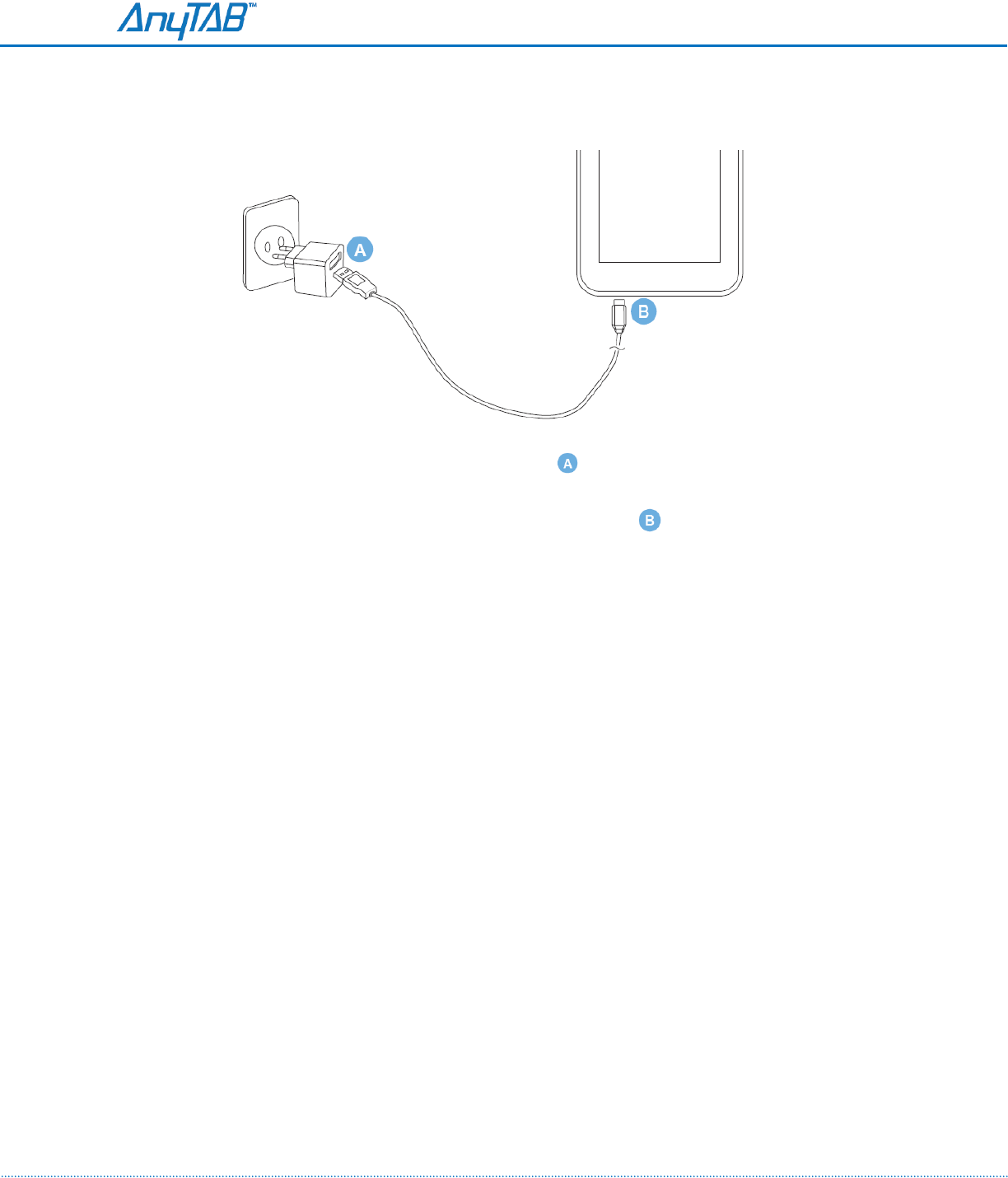
7
Charging the Battery
Before charging the battery, make sure that the battery has been properly inserted into your device.
Connect your USB cable to the charger, as shown in .
Plug the charger into a power socket.
Connect the other end of the cable to your device, as shown in . The device begins charging.
If your device is charged when it is powered off, then a RED LED (next to the USB port) is lighted on. When
the LED color changes to BLUE, it indicates that your device is fully charged.
If you pull out charger while the device is powered off and charging, the device will power down.
If you push the power key while the device is powered off and charging, the device will be powered on.
But if the battery voltage is lower than a proper voltage level, the device will not power on. In this case
you should wait until the battery voltage reaches a proper voltage level.
If your device is charging while it is powered on, the battery icon in the Notification bar shows the charging
status and the LED color next to the USB port is RED while charging. When the battery icon is changed to
GREEN, it indicates that your device is fully charged.
When you are not using functions such as, Wi-Fi, GPS, Bluetooth, and data service, you should switch them
off to reduce power consumption.
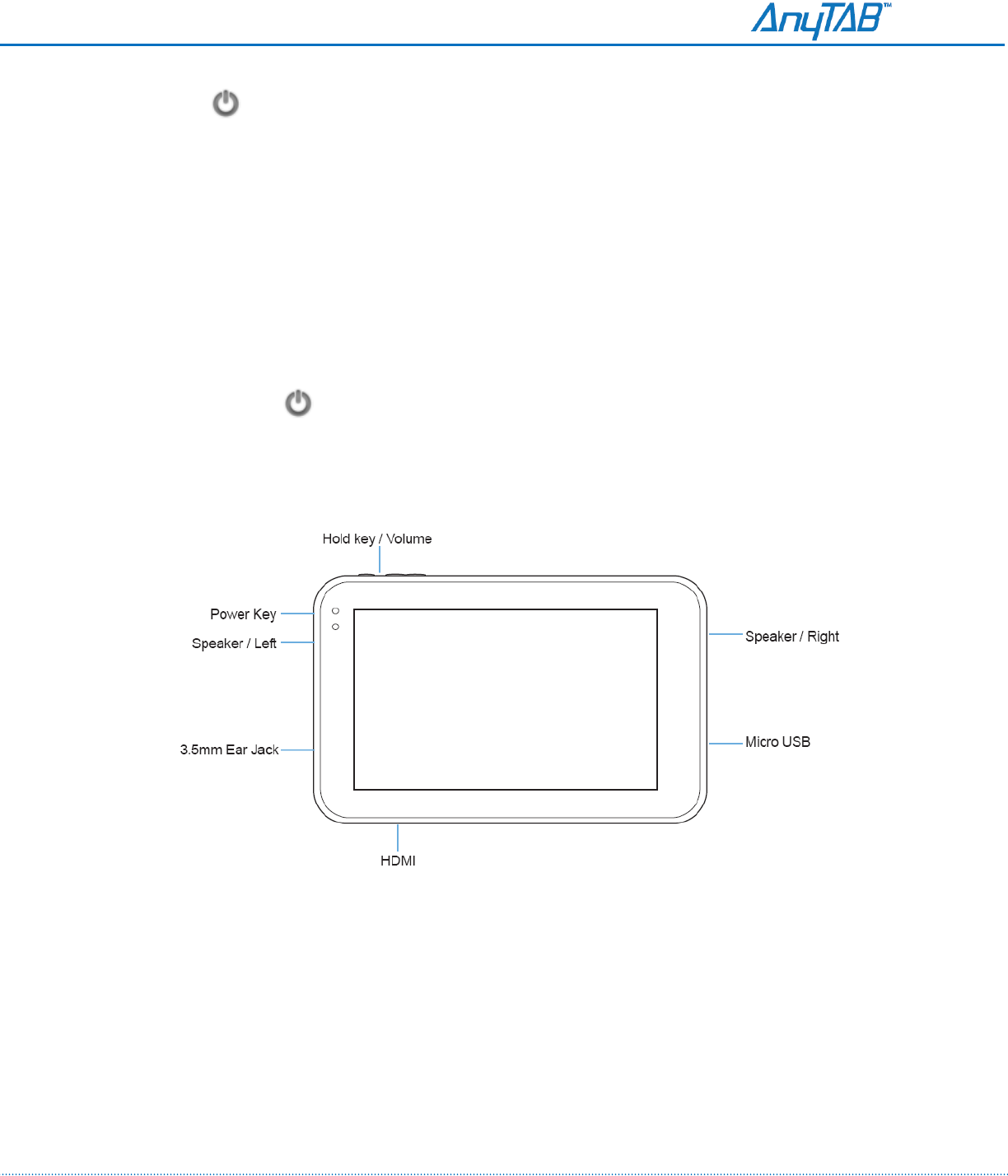
8
Powering On Your Device
Press .
The first time you do this, you will be asked to sign in to your account and set up your device
Using the onscreen keyboard
Setting up your accounts
Other important settings.
Note. You need an internet connection to set up accounts.
Powering Off Your Device
Press and hold
Touch OK when prompted to power off the device
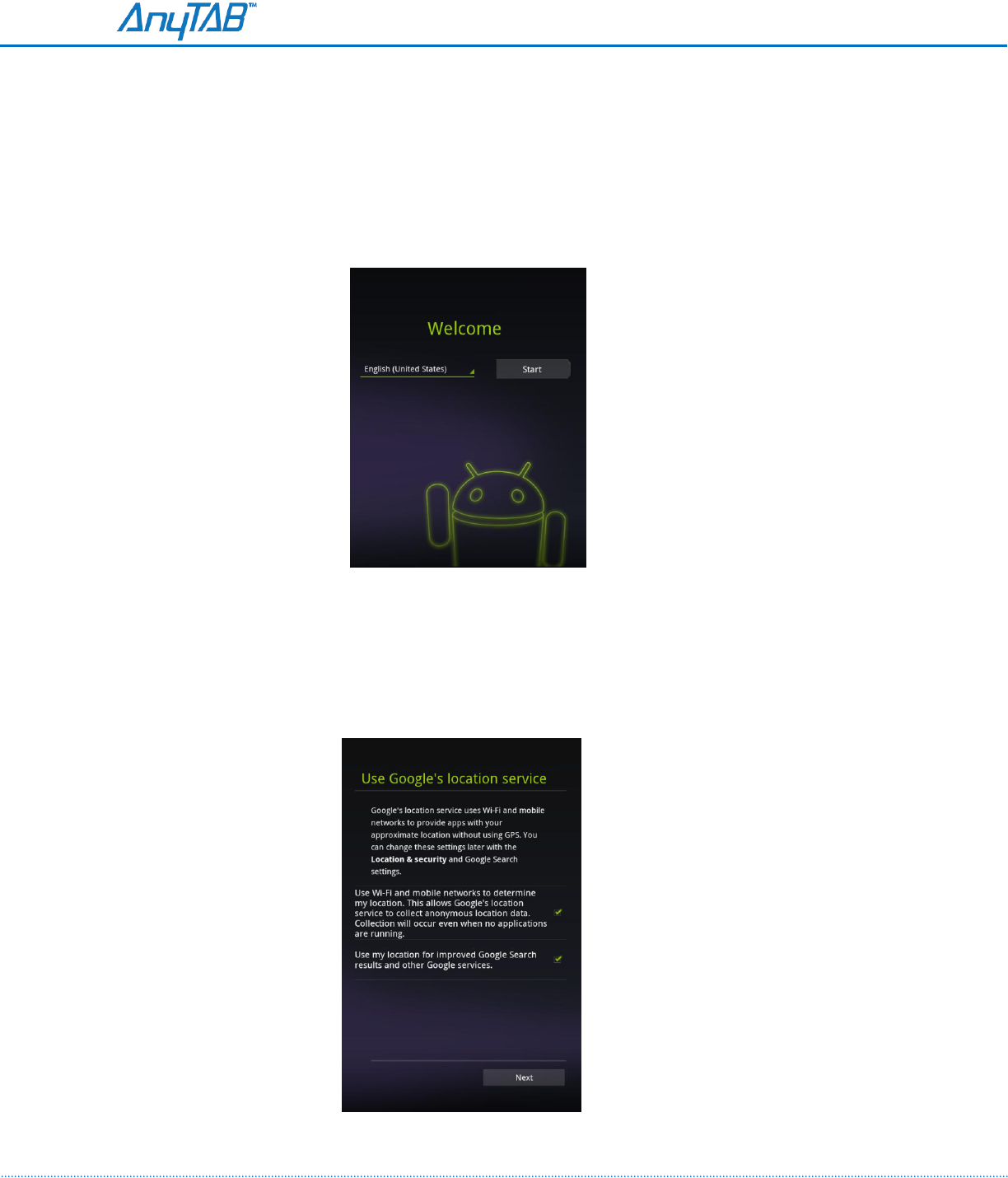
9
Welcome to Android
The first time you power on your AnyTAB device, you’re welcomed to Android and invited to pick a
la
ng
ua
ge
to work in and to start setting up and using your
ta
bl
et.
Touch English if you want to work in a different language
.
Touch Start to start setting up your
tablet.
Setting your location preferences
Google’s location service uses the Wi-Fi network near you
to
make your approximate location available to
your apps. This location information
can make finding your precise location by GPS much faster; it can also
pr
o
v
id
e
your location to apps when GPS isn’t
ava
ilab
l
e
.
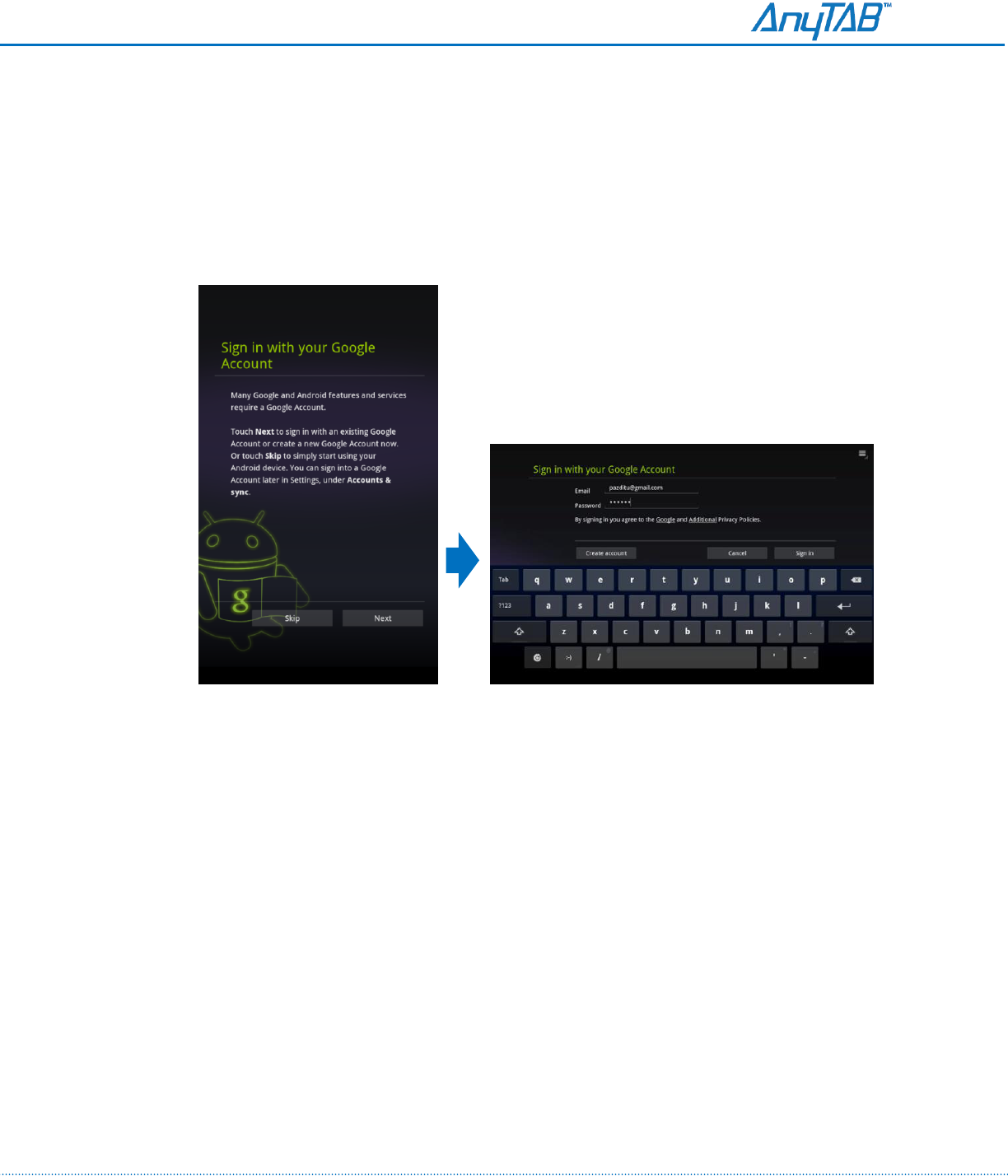
10
Signing into your Google account
Y
o
u
must sign into a Google Account to use Gmail, Google Talk, and other Google Apps; to download apps
from Android Market; to back up your settings and
ot
her
data to Google servers; and to take
advantage
of
other Google services on your
ta
bl
et.
If you don’t have a Google Account, you can also create one by touching Create
Account
.
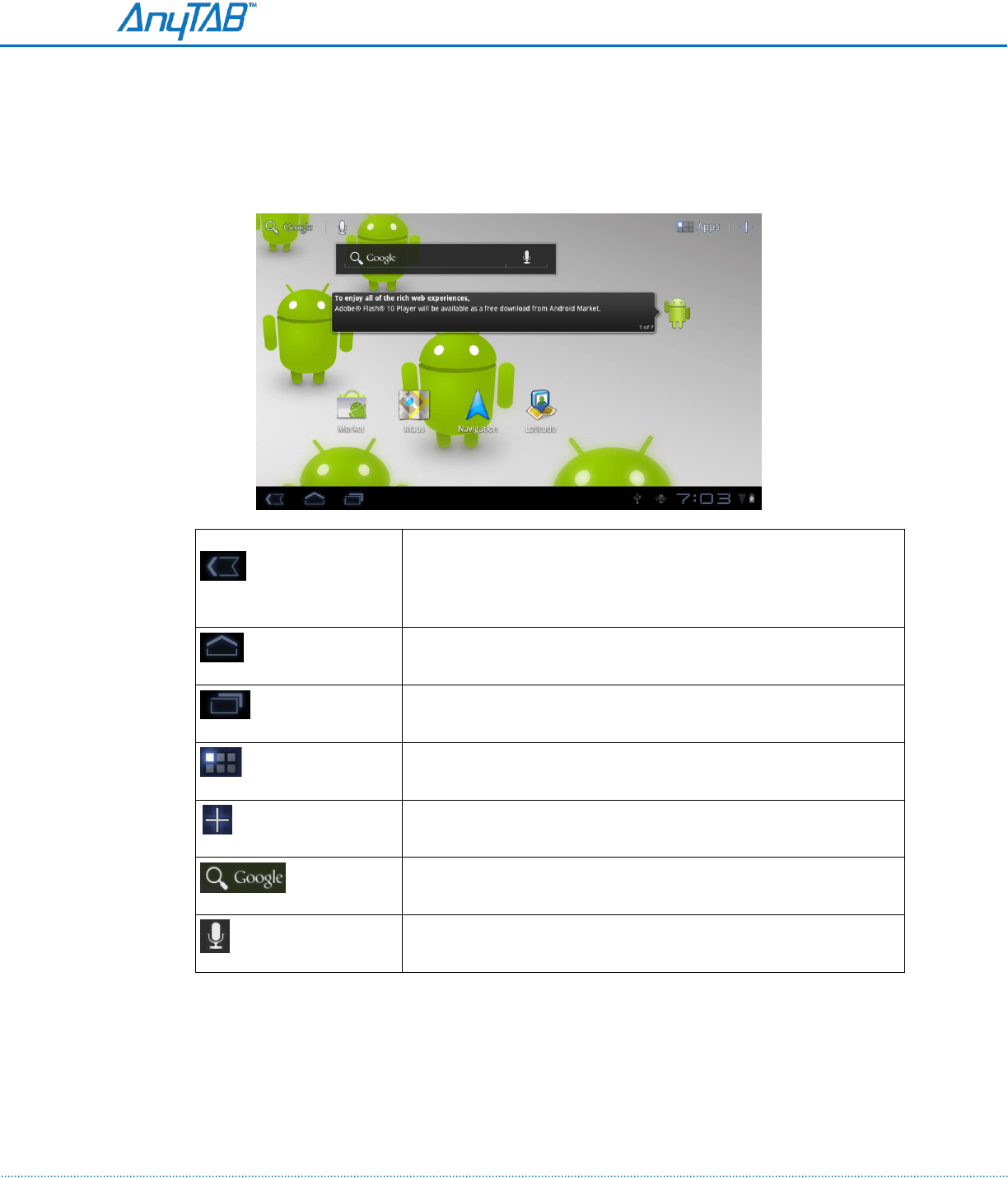
11
Home and Android basics
Once you’ve finished setting up your
tablet,
Home opens. It’s a good idea
to
become familiar with the
basics of your tablet and how to use it—Home and
its
Home
screens,
the
touch screen,
securing your
tablet,
monitoring and
responding
to
status
and
notification messages,
and so
on.
Ba
ck
Opens the previous screen you were working in. If
th
e
onscreen
keyboard is open, the button changes
to a down
arrow and touching it closes the
ke
ybo
a
rd.
Ho
me
Opens Home. If you’re viewing a left or right Home
screen,
opens the central Home
screen.
Re
cent
A
pps
Opens a list of
thumbnail
images of apps you’ve
work
ed
with
recently; touch an app to open
i
t
.
Apps
Opens a thumbnail list of all of your installed apps
Customize
You can use the customize button to add shortcuts to apps and
widgets to your Home screens and to change the wallpaper
.
Search
Touch and add an entry to search your Tablet or the web
Voice Search
Search your Tablet or the web by speaking and voice commands

12
Using the Touchscreen
The main way to control Android
features
is by using your finger to
ma
ni
pulat
e
icons, buttons
,
menu items,
the
onscreen
keyboard, and other items on
th
e
touch screen.
Touch To act on items on the
screen,
such as app and
settings
icons, to
t
y
pe
letters and symbols
using the
onscreen
keyboard, or to press
onscreen buttons,
you simply touch them with your
fi
nger
.
Touch & hold Touch & hold an item on the screen by touching it and not
lif
tin
g
your finger until an
action occurs
.
Drag Touch & hold an item for a moment and then, without lifting your
fi
nger
,
move your finger
on the screen until you reach the target position. For
example,
you drag items on the Home
screen to reposition them.
Swipe or slide To swipe or slide, you quickly move your finger across the
surfa
ce
of the
screen,
without pausing when you first touch it (so you don’t drag an
i
t
em
instead).
For example, you slide
the Home screen left or right to view the
o
t
h
e
r
parts, and in some Calendar views you slide to view
earlier or later
p
e
ri
od
s.
Double-tap Tap quickly twice on a webpage, map, or other screen to zoom. For example, you
double-tap
a section of a webpage in Browser to zoom that section to
fit the width of the
screen.
Double-tapping
after pinching to zoom in some
apps
reflows a column of text to fit the width of the
sc
re
en.
Pinch In some apps (such as Maps, Browser, and Gallery), you can zoom in
an
d
out by placing
two fingers on the screen at once and pinching them together
(to
zoom out) or spreading them
apart (to zoom
i
n
)
.
Rotate the screen On most
screens,
the orientation of the screen rotates with
the tablet as you
turn it.
Y
o
u
have the option to turn this feature on and off.
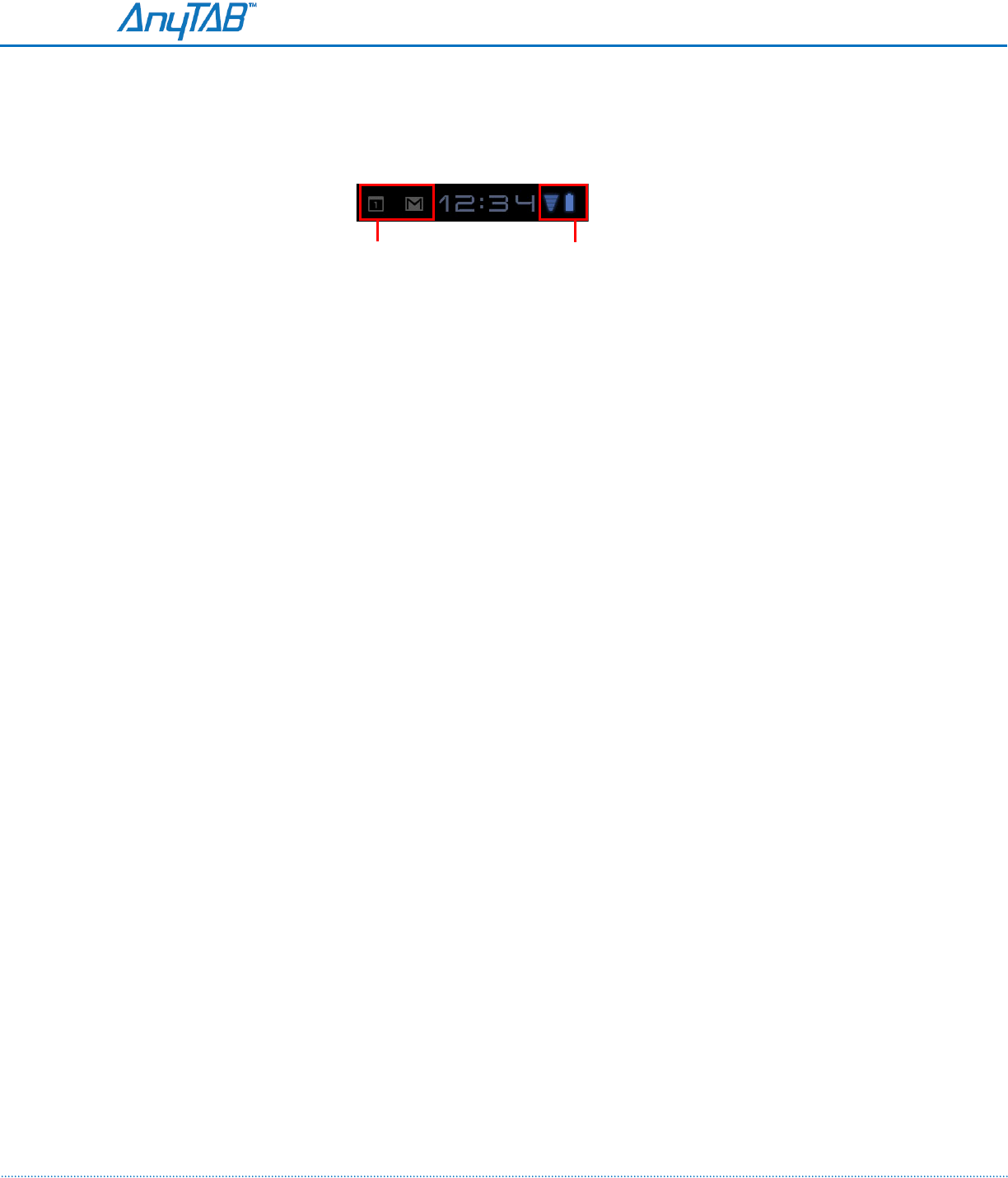
13
Monitoring your Tablet’s status
The right side of the System bar displays icons indicating that you’ve
recei
ved
notifications,
the current time,
and icons indicating the
t
a
bl
et
’
s
stat
us.
Notification icons
Status ic
o
n
s
If you have more
notifications
than can fit in the System bar, a plus icon
prompts
you to open the
Notifications panel to view them all.
Status Icons
Status icons indicate the status of your tablet at the right edge of the System bar and in the Status Detail panel
(which opens if you touch the time). Network Status icons turn blue if you have a Google Account added to your
tablet and the tablet is connected to Google services. Otherwise the network icons are gray.
Notification Icons
Notification icons
indicate
that you’ve received a
notification
from the system or from an
application.
They
appear to the left of the time in the System bar
.
In addition, these icons and apps you install on your tablet
may use
t
h
eir
own notification icons
.
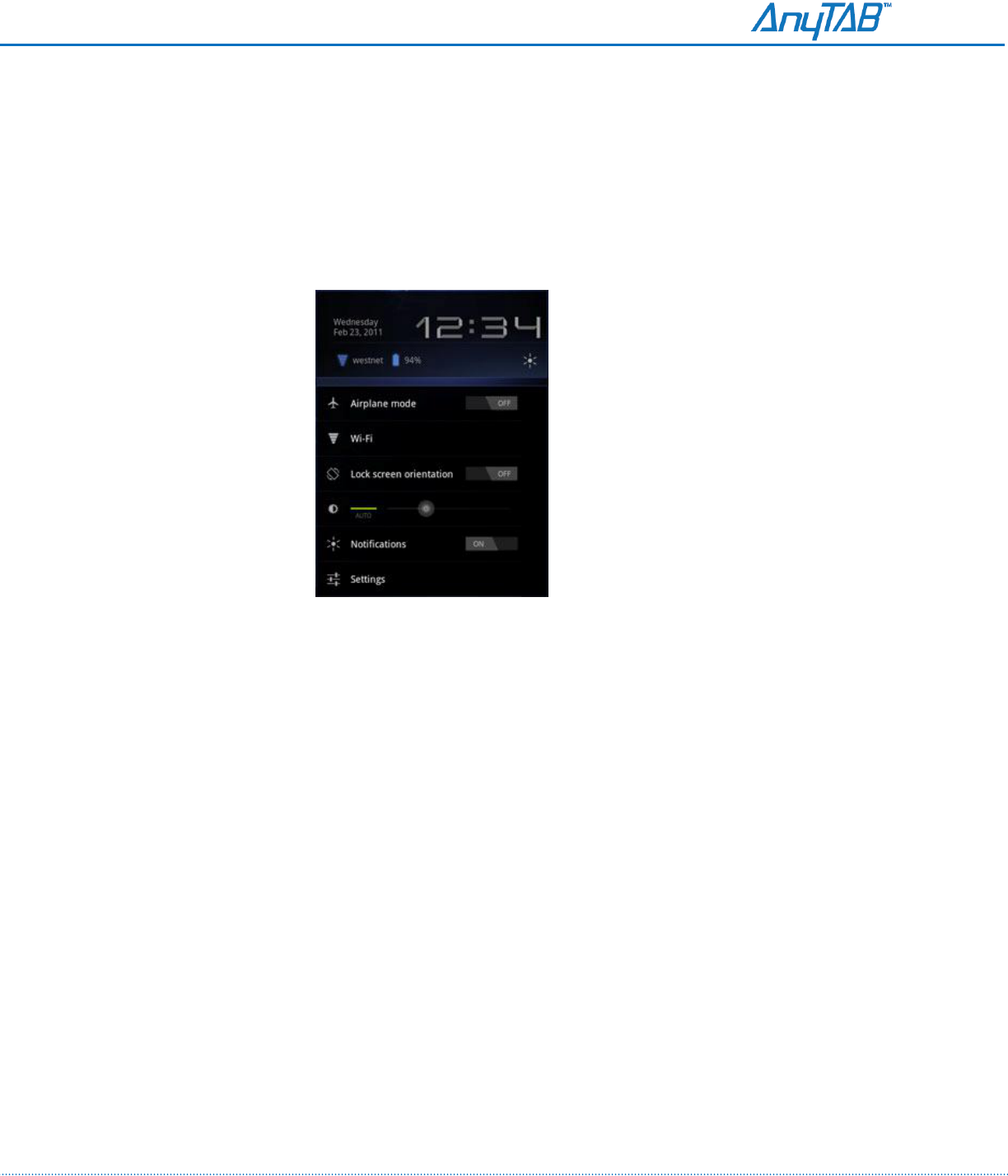
14
Working with Quick settings
The Quick Settings make it
convenient
to view or change the most common
tablet
settings
and to open
the full Settings
a
p
p.
Open the
Status
Detail
s.
Touch anywhere in the
Status
Det
a
il
s
.
The Quick Settings open below the
Status
Details, replacing
the list of
curre
nt
n
o
ti
fic
a
ti
on
s.
View
or change the
settings
you
want.
Y
o
u
can close the Quick Settings again by touching anywhere
else on
t
h
e screen.
The Quick Settings are
:
Airplane mode Drag the switch to On to turn off all the tablet’s radios
tha
t
transmit
data,
including mobile data and Wi-Fi.
Wi-Fi T o u c h to open the Wi-Fi
settings.
Lock screen
orientation
Drag the switch to On to lock the screen in
landsc
ape
orientation,
so it
doesn’t rotate when you turn the
tablet.
Brightness Drag the slider to change the
brightness
of the
screen.
Or touch
Auto
to have the
tablet set screen brightness
automatically,
using its sensors to
measure
the amount of light in your
surroundings.
Notifications
Drag the slider to Off if you don’t want to be
disturbed
by
system
or
application
notifications
about new mail, invitations to chat, and so on.

15
Securing your tablet
Initially, when you turn on or wake the
tablet,
the lock screen requires you to drag
a
lock icon to unlock the
screen.
But you can secure the lock screen by
re
qu
ir
in
g
that
you draw a
pattern
or enter a numeric PIN or
password, so only you can
acce
ss
your data, buy apps from Market, and so on.
Y
o
u
may also be required to
sec
u
re
you lock screen by a policy set by an email
account
or other
account
you add
to
your
tabl
et.
Y
o
u
can also encrypt the data on your
tablet,
so you must enter a numeric PIN or
a
password to
decrypt it each time you power it
on.
Touch Location & security
Touch Configure lock screen
Touch Pattern, PIN, or Password
If you touch
Pattern,
you are guided to create a pattern you must draw to unlock the screen. If
you touch PIN or Password, you’re prompted to set a numeric PIN or password you must enter to
unlock your screen. The next time you turn on your tablet or wake up the screen, you must draw
your unlock pattern or enter your PIN or password to unlock the screen.
Encrypt your tablet
You can encrypt all the data on your tablet including Google accounts, application data, music, and other media.
However, if you do, you must enter a numeric PIN or password each time you power on your tablet.
WARNING! Encryption is irreversible. The only way to revert to an unencrypted tablet is to perform a factory
data reset, which erases all data on the tablet.
Before you can start encrypting your tablet, you must set a lock screen PIN or password and ensure that your
tablet is plugged in. Schedule an hour or more for the encryption process: you must not interrupt it or you will
lose some or all of your data.
Open Settings and touch Location & security > Encrypt tablet.
Read the information on the Encrypt Tablet screen carefully.
Warning!
You must not
interrupt
the encryption process or you will lose
data.
The Encrypt
tablet
button is dimmed if your battery is not charged or if your tablet is not plugged
in
.
If you change your mind about encrypting your
tablet,
touch Back
.
Touch the Encrypt
tablet
button.
Enter your lock screen PIN or password and touch Continue
.
Touch the Encrypt
tablet
button again, to confirm you want to
c
o
nt
in
ue
.
The encryption process starts and displays its
progress.
Encryption can take an hour or more, during
which time your tablet may
r
e
st
art
several
times.
When encryption is
complete,
you’re prompted to
enter your PIN or
password.
Subsequently,
you must enter your PIN or password each time you
power
on
your
tablet,
to decrypt it
.
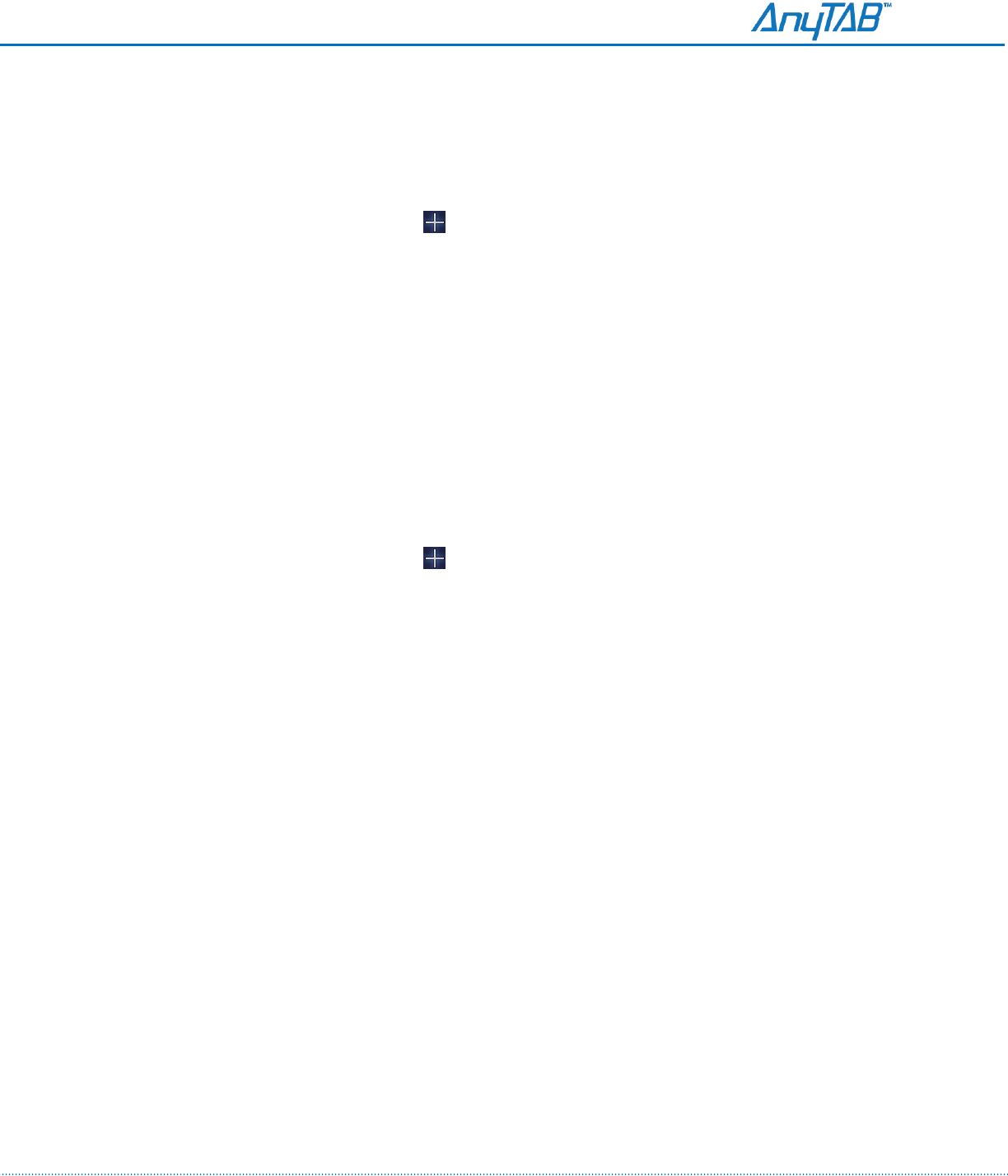
16
Customizing the Homescreen
Y
o
u
can add app icons, shortcuts
,
widgets, and other items to any part of
any
Home screen where
there
’
s
free
space.
Y
o
u
can also change the
wa
llpaper
.
Open the Home screen where you want to add the item.
Touch the Customize button at the top-right of the screen.
Touch the category of the item you want to add.
If there are no empty spots on the Home screen,
Add
is dimmed and you must
delete or move an item before you can add another.
In the menu that opens, touch the tab for the category of the item you want to
add.
Changing Homescreen Wallpaper
Y
o
u
can add app icons, shortcuts
,
widgets, and other items to any part of
any
Home screen where
there
’
s
free
space.
Y
o
u
can also change the
wa
llpaper
.
Touch the Customize button at the top-right of the screen.
Touch
Wallpapers
Touch Gallery, Live
wallpapers
,
or
W
a
ll
pa
pe
rs
.
Touch Gallery to use a picture that you have
captured
using the camera or copied to your
tablet.
Touch Live
wallpapers
to open a scrolling list of
animated
wallpapers
in
sta
l
le
d
on your
tablet.
Some live wallpapers change according to the time of day,
in
response
to touching
the
screen,
tell the time, or offer other information.
So
me
live wallpapers have a
Settings
button.
Touch
Wallpapers
to open a screen where you can sample the
wa
llpaper
images that
come with the
tablet.
Slide the miniature images left and right
to
view the
samples.
Touch a sample to view a larger
ve
rsi
o
n.
Y
o
u
can a l s o download
additional
wallpapers from Android Market.
Touch Save or Set
wallpaper
.
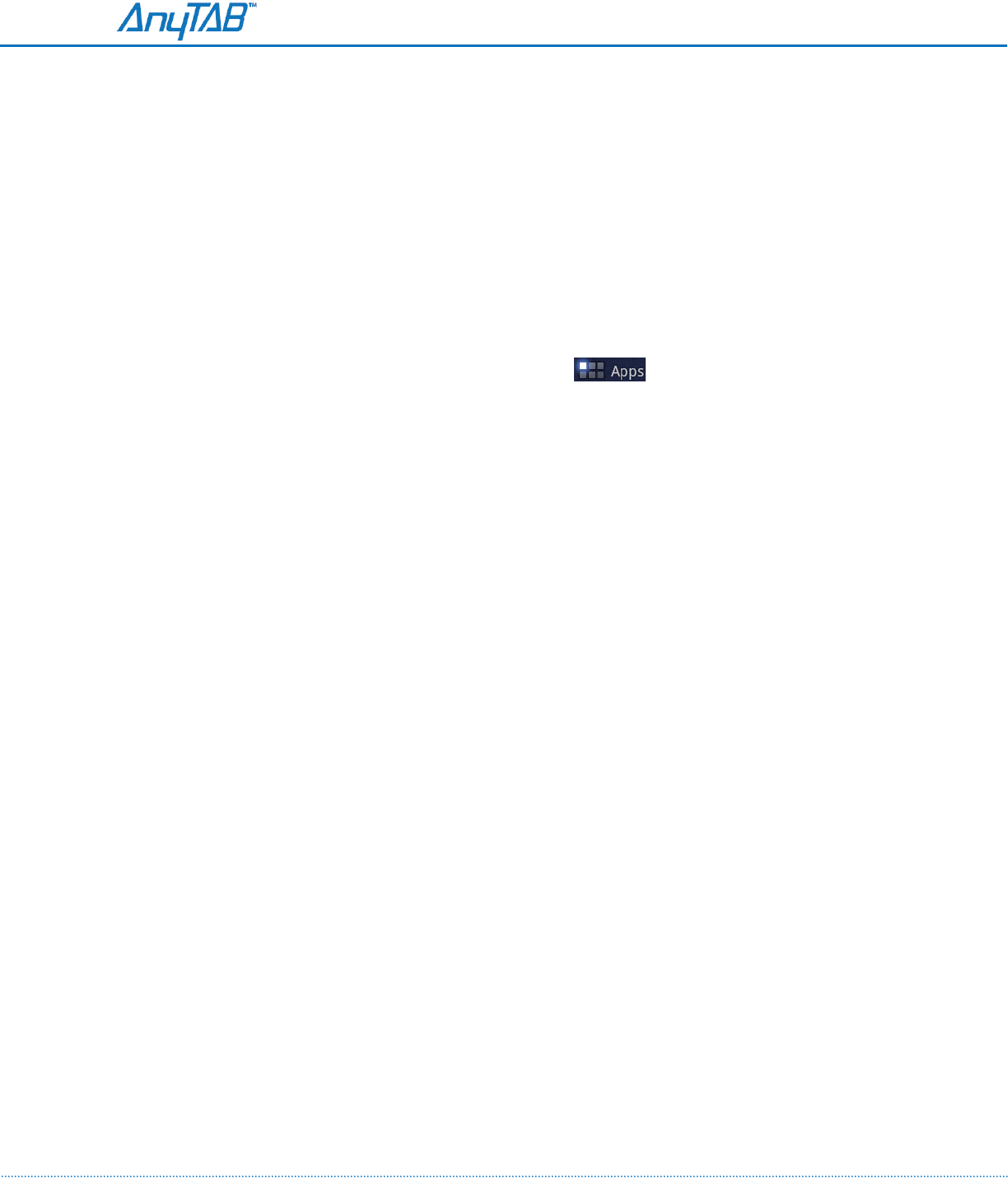
17
Working with Apps
Home’s Apps screen has icons for all of the apps on your
tablet,
including any
apps
that you downloaded and
installed from Android Market or other
source
s.
When you open an app, the other apps you’ve been using
don’t stop; they keep
on
running: playing music, opening
web pages,
and so on.
Y
o
u
can quickly
switch
among your apps, to work with several at once. The Android operating system
and
apps work together to
ensure that apps you
ar
en
’
t
using don’t
consume
resour
ces
un
necessar
il
y
,
stopping and starting them as
needed.
For this reason, there’s
no
need to stop apps unless you’re certain that one you downloaded is
mi
sbe
h
a
v
ing
.
Open the Apps Screen
In Home, touch the Apps button at the top right of the screen.
If you have more apps than can fit on the Apps
screen,
you can slide the
sc
re
en
left or right to view
m
o
re
.
Y
o
u
can add
shortcut
to an app to a Home screen by touching &
holding the
ap
p
on the Apps screen until
outlines of the Home
screens
appear below the
app
icons. Then drag the app icon to the Home
screen.
If
you pause before
releasing your finger on a Home
screen,
that Home screen enlarges
,
so you
ca
n
place the
shortcut
where you want
i
t
.
Uninstall an App
Y
o
u
can uninstall apps you downloaded from Market and other
sources.
Open the Manage Applications screen
.
Touch the
Downloads
tab
.
Touch the app you want to
un
i
n
stal
l
.
Touch the
Uninstall
bu
tt
on
.
Touch
OK
in the screen that asks you to confirm you want to uninstall the
ap
p
.

18
Working with Widgets
Widgets are
miniature
apps that you can place on your Home
screens. Some
widgets are
standalone
applications,
some open a related application
when you touch them, and others provide a subset of useful
information or controls for
th
eir
related applications
.
Stock widgets include a clock, a Gmail widget that displays recent messages
, a
music player, a picture frame,
a
calendar
that shows upcoming appointments
, and
so on.
Y
o
u
can also download widgets from Android
Ma
rke
t
.
Some widgets simply display information and or act as
shortcuts
for opening
their
applications,
such as the Picture Frame
widget.
Some widgets give you controls to view and manage their
application’s
conte
nt,
such as the Clock widget or
the Music Player
widget.
Y
o
u
can scroll information displayed by different widgets in different ways, for example, you can scroll up or
down among events in the Calendar widget, or with
a
carousel effect in the Books widge
t
.
If you touch & hold some widgets, such as the Gmail widget,
handles
appear at
its
edges so you can resize
it.
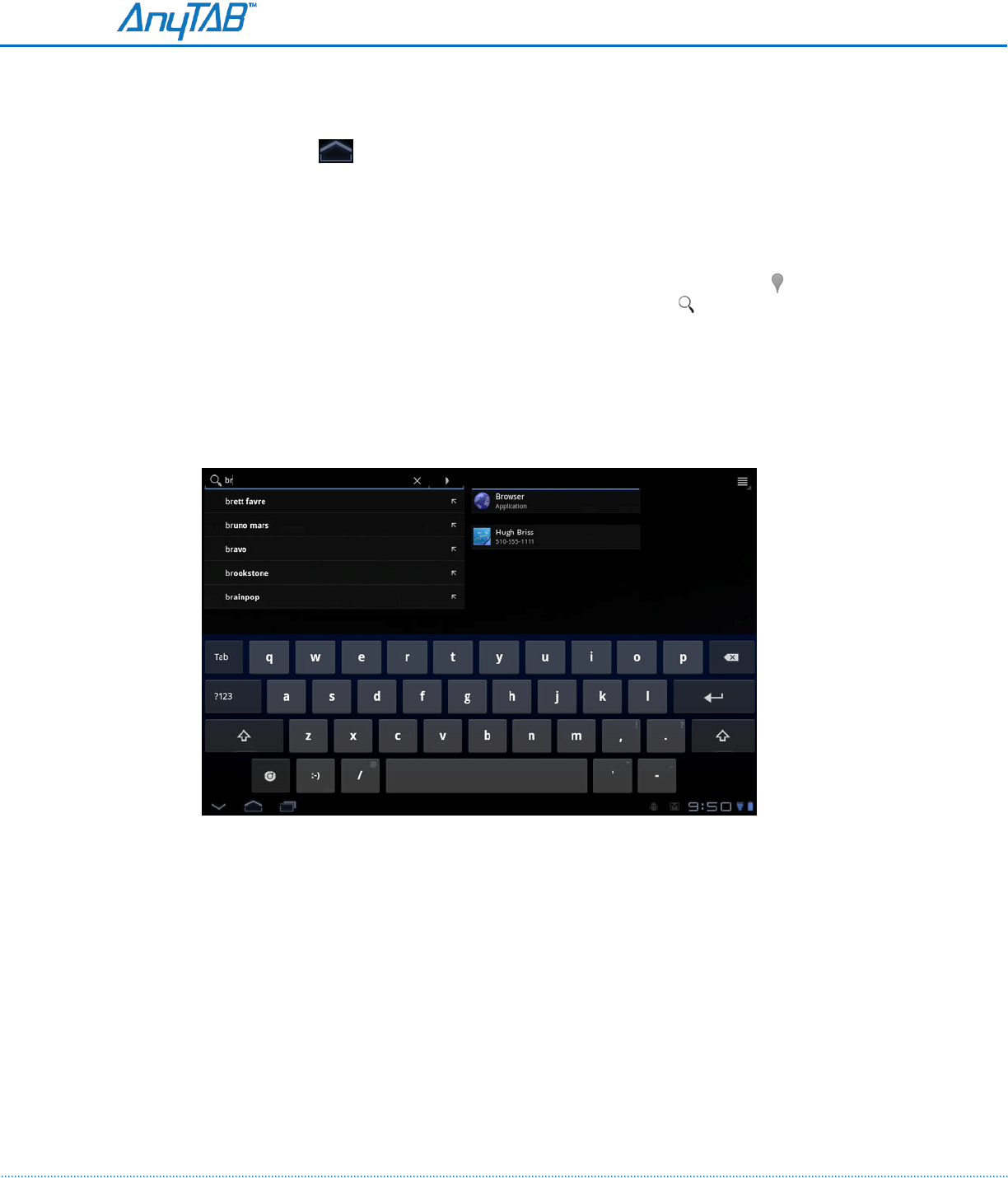
19
Searching your tablet and the web
Y
o
u
can use Google Search to find information on your tablet and the web.
1. Return Home
.
2. Touch the Google Search button at the top left of the screen
3. Start typing what you want to search for
.
As you type,
suggestions
from Google web search appear below the Search box, and results from your
tablet and local
searches
appear to the
right.
Y
o
u
can touch a suggestion’s arrow icon to enter it in the
Search box. If you
do
,
new
suggestions
appear and you can enter more text or touch the arrow
i
c
on
next
subsequent suggestions
to quickly refine your
sea
r
ch.
Business
listings are
indicated
by a Maps marker
icon. Touch one to open
a business
listing panel, with icons you can touch to call, map, get details
ab
ou
t,
or add the
business
to your
contacts.
In
applications
such as Gmail and Contacts, the
application’s
own
search box opens when you touch the Search button.
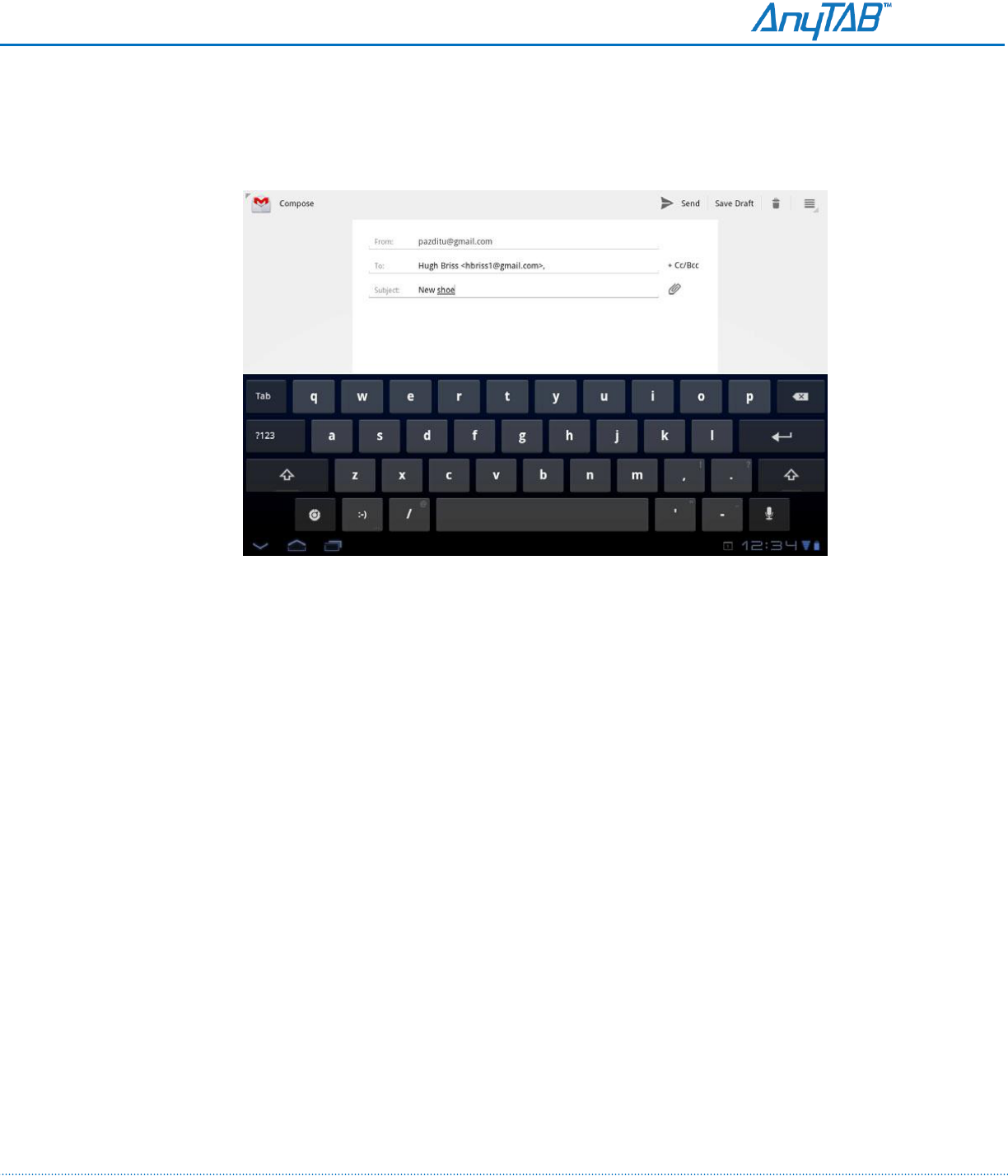
20
Using the Android keyboard
Y
o
u
can enter text using the
onscreen
keyboard. Some apps open the
ke
yboa
rd
au
to
ma
tic
a
ll
y
.
In others,
you touch a text field where you want to enter text to
op
en
the
ke
ybo
a
rd.
Touch a text field to open the
ke
ybo
a
rd
.
The onscreen ke y bo a r d
ope
n
s.
Touch the keys on the keyboard to enter
te
xt.
As you type, words that the keyboard has
suggestions
for are
underli
ned.
If you set the keyboard to show correction
suggestions,
they appear in a
strip
above the
keyboard. The
underlined
word in the strip is the
suggested
word.
Y
o
u
can also touch another word in the
strip to enter it
instead.
Y
o
u
can turn the suggestion feature on or off and change whether
suggestions
a
r
e
shown with the Android keyboard
settings.
Enter text by speaking
Y
o
u
can use voice input to enter text by
speaking.
V
o
ic
e
input is an
experimental
feature that uses Google’s
speech-recognition
service, so you must have a
da
ta
connection
on a mobile or Wi-Fi network to use
i
t
.
Connecting to Networks and Devices
Y
o
ur
tablet can
connect
to
Wi-Fi data networks, and Bluetooth devices,
such
as
headsets.
Y
o
u
can
connect
your tablet to a
computer,
to transfer files from your
tablet,
using a USB
connection
or
Bluetooth,
or to a keyboard, mouse, other
input
devices, or to a camera to import its photos.
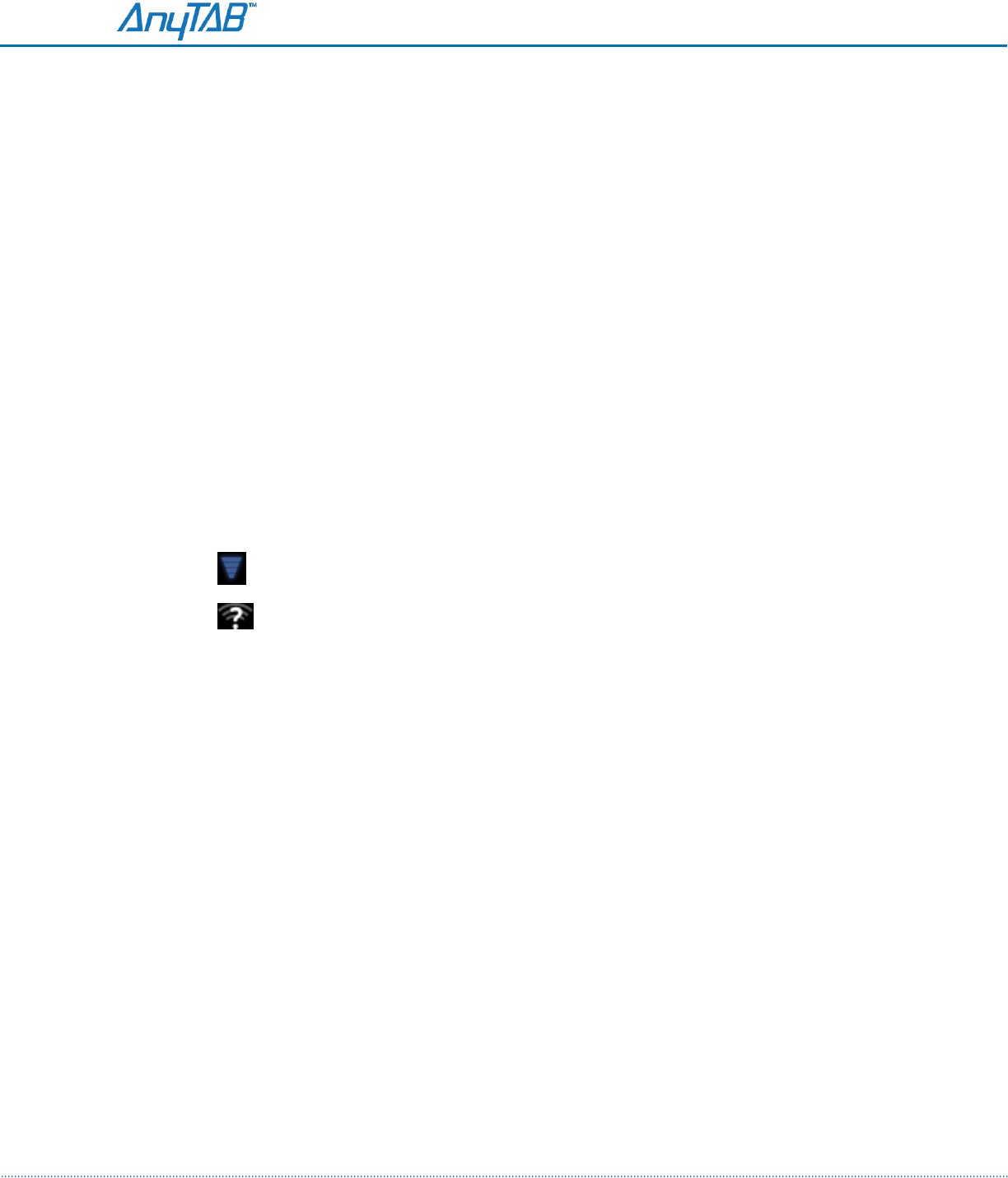
21
Connecting to WiFi Networks
Wi-Fi is a wireless networking technology that can provide
Internet access
at
distances
of up to
100
meters, depending
on the Wi-Fi router and your
su
rr
ou
ndi
ngs.
To use Wi-Fi on your
tablet,
you
connect
to a wireless
access
point, or
“hotspo
t
.”
Some
hotspots
are open
and you can simply
connect
to them. Others
i
m
ple
m
e
n
t
security
features,
so you must configure your
tablet so it can
connect
to
t
h
e
m
.
There are
numerous
systems for securing Wi-Fi
connections,
including some
that
rely on secure
certificates
or other
schemes
to ensure that only authorized
users
can
connect.
Turn off Wi-Fi when you’re not using it, to extend the life of your battery
betwee
n
charges.
Y
o
u
can also set
whether you want to
disconnect
from Wi-Fi
n
e
twork
s
when your tablet is sleeping.
The
Status
bar displays icons that
indicate
Wi-Fi
sta
t
u
s
.
Network
status
icons turn blue if you have a Google Account added to your
tabl
et
and the tablet is
connected
to Google services, for syncing your Gmail, Cale
nd
ar
events,
contacts,
for backing up your
settings,
and so on. If you don’t have
a
Google Account or if, for example,
you’re
connected
to a Wi-Fi
network that is
not
connected
to the
Internet,
the network icons are
gray
.
Connected to a Wi-Fi network (waves
indicate connection
st
ren
g
t
h
)
Notification that an open Wi-Fi network is in
range

22
Turn WiFi on and Connect to a Network
Open the Settings
a
p
p.
Touch
Wireless
&
networks
>
Wi-Fi
setti
ngs
.
Check Wi-Fi to turn it
on
.
The tablet scans for available
Wi-Fi
networks and displays the names of those
it
finds.
Secured networks are
indicated
with a Lock
i
con.
If the tablet finds a network that you
connected
to previously, it
connects
to
it.
Touch a network to
connect
to
it.
If the network is open, you are prompted to confirm that you want to
connect to
that network by touching
Connect
.
If the network is
secured,
you’re prompted to enter a password or
o
t
her
credentials.
(Ask your network
administrator
for
detai
l
s.)
By
default,
you obtain an
address
on the network from the network itself,
usin
g
the DHCP
protoco
l.
Y
o
u
can touch
DHCP
to change the IP
settings
to
Static
,
so you can enter
an
address and other network
details manually, if you or your
netw
ork
administrator
require it. If you do, you must
enter:
An IP address for your tablet that is valid and unique for your Wi-Fi
network
The Gateway for the
ne
twork
The network prefix length (a number between 0 and 32, such as 24 for
a Class C network,
16 for a Class B, or 8 for a Class A network)
At least one DNS server for the
network
When you’re
connected
to a network, you can touch its name in the Wi-Fi settings screen for
details about the
speed,
security,
address,
and
relat
e
d
settings.
Modify how you connect to a WiFi Network
Touch & hold a network in the
list
Touch Modify
network
in the dialog that
o
p
e
n
s.
Change the
settings
you
want.
Touch
Save
.

23
Add a WiFi Network
Y
o
u can add a Wi-Fi network so the tablet will remember it, along with any security credentials and connect
to it automatically when it is in range. You must also add a Wi-Fi network to connect to it, if the network
does not broadcast its name (SSID), or to add a Wi-Fi network when you are out of range of it
.
To join a
secured
network, you need to
contact
the network’s
administrator
to
lea
r
n
what security
scheme
is deployed on it and to obtain the password or
other required
security
credentials.
Turn on Wi-Fi, if
it
’
s
not already
on
.
If you’re adding a Wi-Fi network when first setting up your
tablet,
Wi-Fi
is
turned
on
automatica
lly
.
In the Wi-Fi
settings screen,
touch Add
Wi-Fi
network
(at the bottom of
t
h
e
list of
discovered
networks).
Enter the SSID (name) of the
net
w
or
k.
If
necessar
y
,
enter security or other network configuration
d
e
t
a
il
s.
Touch
Save
.
The information about the network is saved, so you are
connected automatica
lly
the next time you
come within range of this
ne
twor
k.
Forget a WiFi Network
Y
o
u can make the tablet forget about the details of a Wi-Fi network if you don’t want the tablet to connect
to it automatically, or if it’s a network you no longer use.
Turn on Wi-Fi, if
it
’
s
not already
on
.
In the Wi-Fi
settings screen,
touch the name of the
ne
twor
k.
Touch Forget in the dialog that
opens.
Set a Wi-Fi disconnect policy
By
default,
the tablet
disconnects
from Wi-Fi when the screen turns off
and
connects
to a mobile data
network
instead.
It does this to conserve battery power
,
and
reconnects
to Wi-Fi again when you wake
it.
Y
o
u
can change this policy to stay
connected
to
Wi-Fi
when the tablet is
co
nnected
to a charger (when
battery life isn’t a problem), or never to
disconnect
from Wi-Fi, which trades battery life for
reduced
mobile
network data
use.
On the Wi-Fi
settings screen,
touch Wi-Fi
disconnect p
oli
c
y
.
Touch the policy you want
.

24
Connecting to Bluetooth devices
Bluetooth is a short-range wireless
communications
technology that devices
ca
n
use to exchange
information over a
distance
of about 8
meters.
The most
common
Bluetooth devices are
headsets
for
making calls or listening to music,
han
d
s-f
r
ee
kits for cars, and other portable devices, including
la
ptops.
There are several Bluetooth profiles that define the
features
and
comm
uni
cat
i
on
s
standards
for Bluetooth
devices. To
connect
to a Bluetooth device, you must turn on your
t
a
b
l
et
’
s
Bluetooth
radio.
The first time
you use a new device with your
tablet,
you must “pair” the devi
ce
with your
tablet,
so that both devices
know how to
connect
securely to each
other
.
After that, you can simply
connect
to a paired
de
vice
.
Turn off Bluetooth when you’re not using it, to extend the life of your
batt
ery
between charges.
Y
o
u
may
also be required to turn Bluetooth off in some
lo
cations.
Bluetooth is turned off when you switch to
Airplane
mode.
System bar icons
indicate
Bluetooth
status.
To turn Bluetooth on or off:
Open the Settings
appli
cation.
Touch wireless and networks
Check or uncheck Bluetooth
Changing your tablet’s Bluetooth name:
Y
o
u
r
tablet has a generic Bluetooth name by
default,
which is visible to
oth
e
r
devices when you
connect
them.
Y
o
u
can change the name so that it is
more re
cog
nizabl
e.
Open the Settings
appli
cation.
Touch wireless and networks – Bluetooth settings.
Check Bluetooth to turn it on.
Touch Device name , enter a name, and touch OK.

25
Pairing your tablet with a Bluetooth device:
Y
o
u
must pair your tablet with a device before you can
connect
to it. Once you
pai
r
your tablet with a device,
they stay paired unless you unpair
them.
Open the Settings
appli
cation.
Touch Wireless & networks > Bluetooth settings.
Check Bluetooth to turn it on.
Your tablet scans for and displays the IDs of all available Bluetooth devices in range.
If the device you want to pair with isn’t in the list, ensure that the other device is turned on and
set to be discoverable.
If your tablet stops scanning before your other device is ready, touch Find nearby devices and
then Scan for devices.
Touch the ID of the other device in the list in the Found list to pair them.
The devices pair with each other. If you’re prompted to enter a passcode, try entering 0000 or
1234 (the most common passcodes), or consult the documentation that came with the device to
learn its passcode, or what other procedures it requires for pairing.
If the pairing is successful, your tablet connects to the device.
Connect to a Bluetooth device:
Once paired you can connect to a Bluetooth for example, to switch devices, or to re-connect to a device that has
come back into range.
Open the Settings
appli
cation.
Touch
Wireless
&
networks
>
Bluetooth
sett
ings
.
Check
Bluetooth
to turn it
on.
In the list of devices, touch a paired but
unconnected
device in the
li
st.
- If the device you expected isn’t
displayed,
touch Scan for
devices
.
- When the tablet and the device are
connected,
the device is displayed
a
s
connected
in the
li
st.

26
Connect to a Camera:
If you have a camera or other device that
supports
the PTP protocol, you
can
connect
it to your tablet’s
USB port and import the
pictures
on the camera
into
Gallery your
tablet.
Be sure to read the owner’s guide for your camera to learn what protocols
it supports
and whether it can
use PTP over USB.
Y
o
u
may need an
adapter
cable
to
connect
your camera’s USB cable to your tablet: see
your tablet’s owner’s
guide.
Connect your camera to your tablet using your
camer
a
’
s
USB cable and, if
necessary,
an
adapter
from your tablet’s
manufacturer
for its USB
p
or
t
.
Gallery opens, with your cameras’ photos added as an album, labeled Touch
to
import
.
Touch the album of your
cam
e
r
a
’
s
phot
o
s.
The album opens with all of your camera’s photos
selected
for importing
to
Gallery on your
tablet.
Select the photos you want to
i
m
por
t
.
The number of photos
selected
(initially, all) is displayed as the title of a
menu
in the Application
bar
.
You
can touch the menu and touch
Deselect
all if you want to select just
the
photos you want to
import. If all photos
are
n
’
t
selected,
Deselect
all
chan
g
es
to
Select
all in the
me
nu
.
Y
o
u
can also touch individual photos to select or
deselect them.
Touch
Import
at the top-right of the Application
ba
r
.
A dialog displays the progress of importing the photos you
sel
ected.
Touch
Done
in the Application bar and
disconnect
your
camer
a
.
Connecting to a Windows computer via USB
Y
o
u
can use the USB cable that came with your tablet to
connect
it to a Windows
computer,
to transfer
music,
pictures,
and other files between your tablet and
the
computer.
This
connection
uses the MTP
protocol, which is
supported
by
most
recent versions of
W
i
ndows.
Use the USB cable that came with your tablet to
connect
the tablet to a
U
S
B
port on your
comp
ut
er
.
Y
o
ur
table
t
’
s
USB storage or SD card is mounted as a drive on your
computer
.
Y
o
u
can now copy files back and
forth as you would using any other
external
device. For more information, see the
documentation
for your
co
mputer
.
When you’re done, simply
disconnect
the tablet from your
computer
by unplugging the USB
cabl
e.

27
Connecting to a Macintosh computer via USB
Y
o
u
can
connect
your tablet to a
computer
running Mac OS
X
with a USB cable,
to
transfer music,
pictures,
and other files between your tablet and the
computer
.
This
connection
uses the MTP protocol, which is not
supported
by Mac OS
X
natively, so you first need to
install the free Android File Transfer
application
o
n
your
Macintosh.
It’s available from
http://www.android.com/filetransfer,
along
wi
th
instructions
on how to install
i
t
.
Use the USB cable that came with your tablet to
connect
the tablet to a
U
S
B
port on your
comp
ut
er
.
Y
o
ur
table
t
’
s
USB storage or SD card is mounted as a drive on your
computer
.
Y
o
u
can now copy files back and
forth as you would using any other
external
device. For more information, see the
documentation
for your
co
mputer
.
When you’re done, simply
disconnect
the tablet from your
computer
by unplugging the USB
cabl
e.
Optimizing battery life
Y
o
u
can extend your battery’s life between charges by turning off features you don’t need. You can also monitor
how apps and system resources consume battery power.
If you
d
o
n
’
t
need them, turn off
automatic
syncing
for Gmail,
C
a
len
d
a
r
Turn off radios that you aren’t
using.
If you aren’t using Wi-Fi, Bluetooth, or GPS, use the Settings app to turn
the
m
off.
Turn down screen
brightness
and set a shorter screen
ti
meou
t.
If you
d
o
n
’
t
need them, turn off
automatic
syncing for Gmail,
C
a
len
d
a
r
,
Contacts,
and other
apps.
Use the Quick Settings to check and control the
status
of radios, the
display
brightness,
and
syncing.
If you know you won’t be near a mobile or Wi-Fi network for a while, switch
to
Airplane
mode.
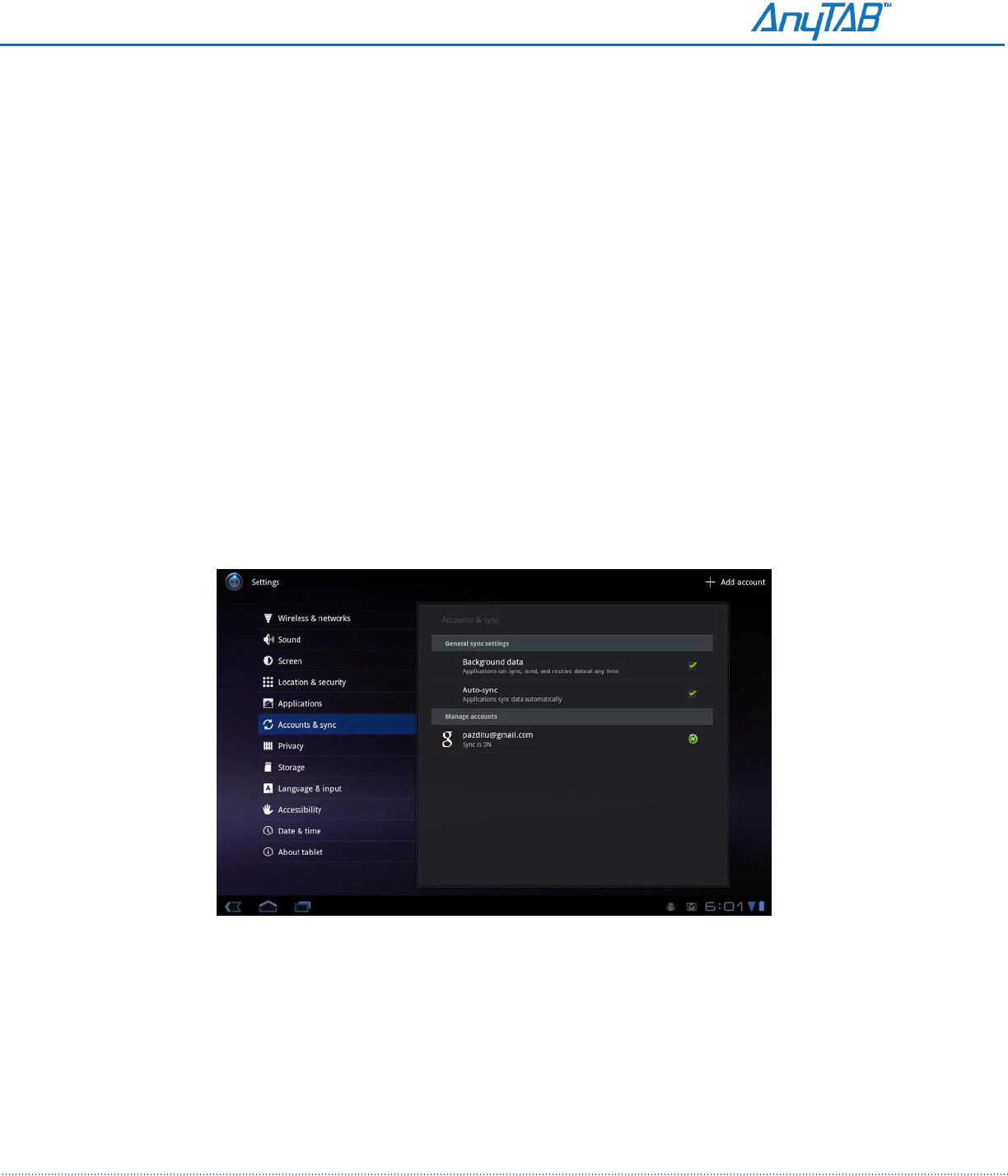
28
Accounts
Y
o
u
can sync
contacts,
email,
calendar
events, and other information with your tablet from multiple
Google Accounts or other kinds of
accounts, depending
on
the
applications installed
on your
tablet.
For example, you could start by adding your personal Google Account, so your personal email,
contacts,
and
calendar
are always available. Then you could add
an
account
from work, so you can read your work
email and have your work
contacts
handy
.
Y
o
u
configure how your
account interacts
with the
applications
on your tablet
using
the Account & Sync
settings
and the setting s in Gmail, Calendar, Email, and
other
applications.
Use a web browser to change
your password and other
general
account settings.
Adding accounts
.
Y
o
u
can do this by opening the
Settings application
and touching
A
ccount
s
& sync. Many
applications
also
have an Accounts button or menu item on
the
screens
where you work with
accounts.
For example, in the
Contacts
a
ppl
i
c
at
io
n
you can touch the Menu button in the top-right of the Application bar and
th
en
touch
Accounts
.
The Accounts & Sync Settings screen displays your current sync
settings
and
a
list of your current
acco
unts.

29
Removing accounts
.
Y
o
u
can do this by opening the
Settings application
and touching
A
ccount
s
& sync. Many
applications
also
have an Accounts button or menu item on
the
screens
where you work with
accounts.
For example, in the
Contacts
a
ppl
i
c
at
io
n
you can touch the Menu button in the top-right of the Application bar and
th
en
touch
Accounts
.
You can remove an account to delete it and all information associated with it from your tablet,
including email, contacts, settings, and so on.
1.
Open the Accounts & Sync
setti
ngs.
2. Touch the
account
to
dele
te
.
3. Touch
Remove
account
.
4. Confirm that you want to remove the
acc
ount.
Contact
s
Contacts gives you quick and easy
access
to the people you want to reach. When you first turn on your
tablet and sign into a Google Account, any existing
contacts
from that
account
are downloaded to your
tablet.
After that, your
contacts are
synchronized:
any
changes
you make to your
contacts
on the
tablet,
on the web, or on another device are made everywhere the next time you
sync.
Information about your
contacts
is shared with other
applications,
such a Gmai
l,
Google Talk, and so
on.
If you have more than one
account
with
contact information,
Contacts
joins
duplicates
into a single entry.
Y
o
u
can also manage that process
manuall
y
.
Touch the Contacts icon on the Apps screen or touch a shortcut icon on a Home screen.
Y
o
ur
contacts
are displayed
alphabeti
call
y
at left, in a scrolling list, with
th
e
details of the currently
selected
contact
in the main part of the
screen.
Y
o
u
can drag the list of
contacts
up or down to scroll it, or drag the scroll
knob
to scroll
qu
ic
kly
.
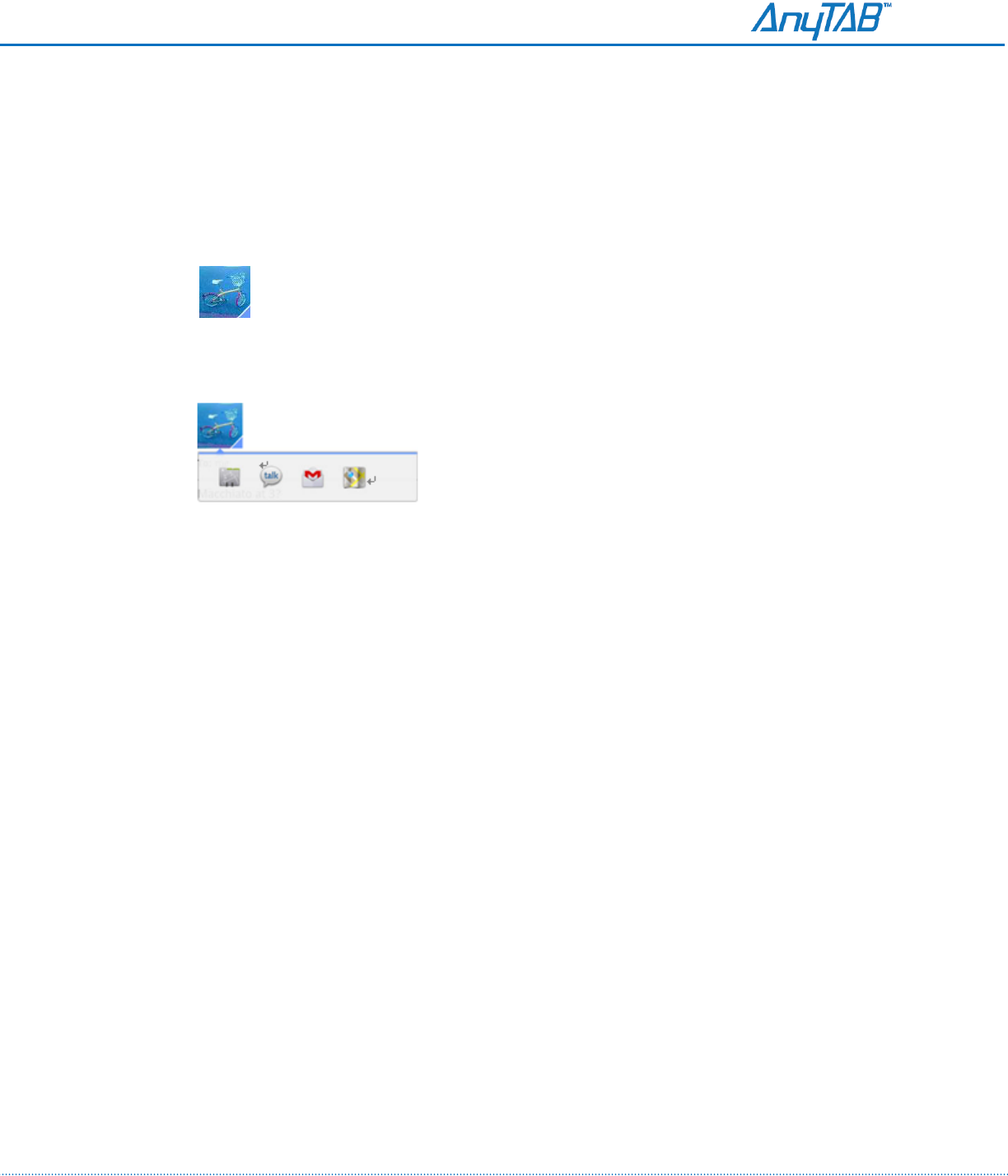
30
Connecting quickly with your contacts
As you build up your list of
contacts,
you can use Quick Contact for Android
in
many apps to quickly start a
chat, email, or to locate your
contacts
on a
map.
Identify a Quick Contact icon by its
frame.
Contacts that you can
access
with Quick Contact are displayed differently
in
different apps,
but usually with a picture frame that looks like
thi
s
:
Touch a Quick Contact icon to open a bubble with icons for all the ways you
can
communicate
with the
c
o
ntact.
If there are more icons than can fit in the bubble, drag them left and right
to
view them
all.
Touch an icon to open its app, where you can start
communicating
with your
contact
right
a
w
ay
.
Y
o
u
can also touch an icon to edit the
contact’s
information in Contacts, to view the
co
nt
ac
t
’
s
address
in Google Maps, and so on,
depending
on which apps
an
d accounts
are configured on
your
tablet.
Y
o
u
can add a shortcut for a
contact
to your Home
screen,
which you can
the
n
touch to open
Quick Contact for Android for that
contact.
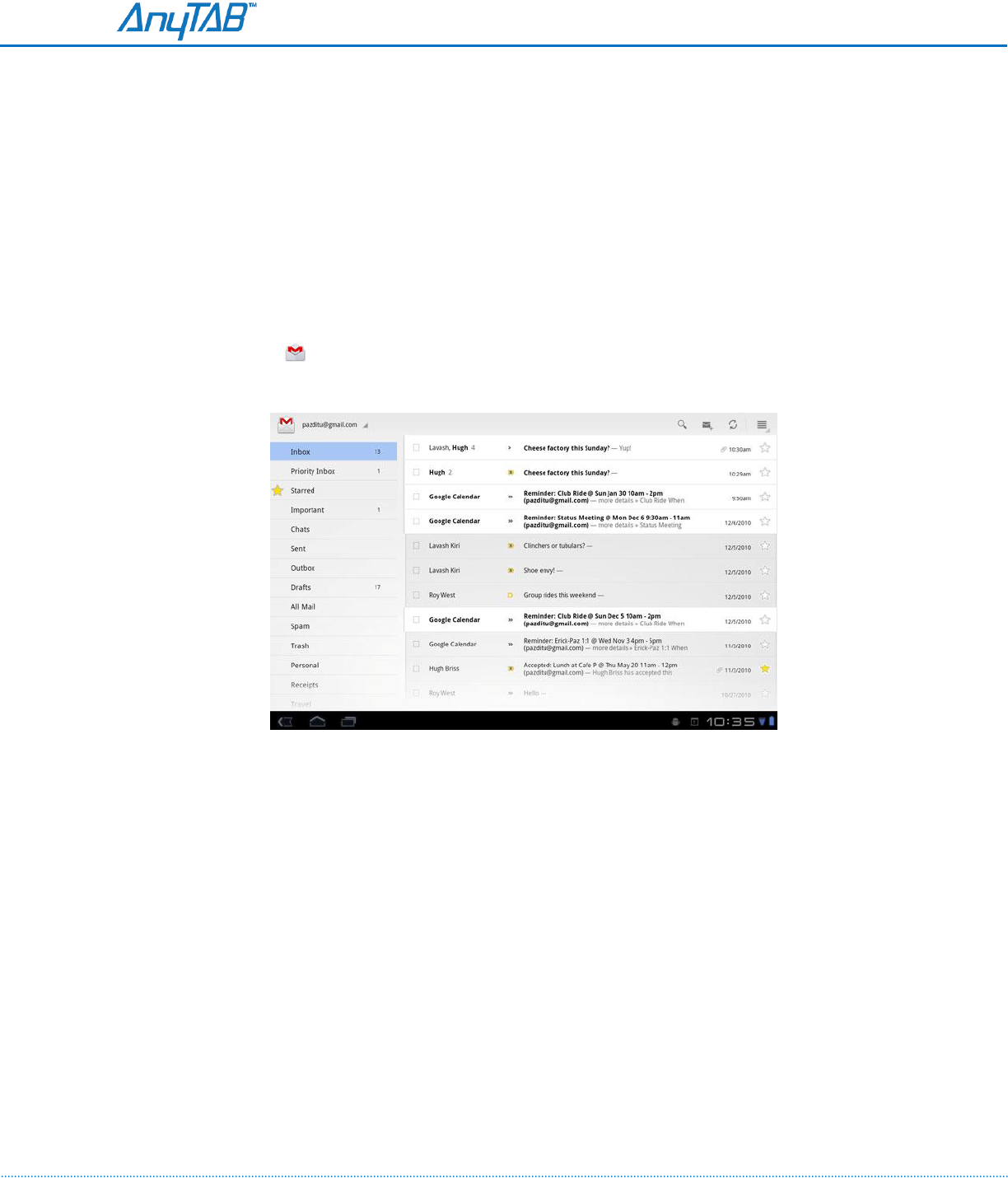
31
Gmail
Gmail is an Android
application
for working with Google’s web-based email
service.
When you first set up
your
tablet,
you were
prompted
to sign into an
existing
Google Account or to create a new
account.
When you open Gmail on your
tablet,
your Inbox contains the
messages
from your Gmail
accounts
on the
web.
Information about your
contacts
is shared with other
applications,
such a Gmai
l,
Google Talk, and so
on.
When you open Gmail, your most recent
conversations
are displayed in your
Inbox.
When you return to
Gmail after using other
applications,
the last screen you
w
e
re
working with is
displayed.
Touch the Gmail icon on the Apps screen or touch a
shortcut
icon on
a
Home
sc
ree
n
.
Gmail opens with a scrolling list of labels on the left and the contents of your Inbox on the right, with the
conversation with the newest messages on top. All of your conversations are displayed in the Inbox unless you
Archive, Delete, or Filter them.

32
Calendar
Calendar on your tablet works with the web-based Google Calendar
calendaring
service for creating and
managing events,
meetings,
and
appointments.
Calendar on the tablet is optimized for the
tablet.
Some Calendar
features,
such
as
creating Calendars,
are only available in Google Calendar on the web (visit
http://
calendar.google.com
to learn about the
features
of the web version of
Calendar).
Viewing your calendar and events
Open Calendar to view events you’ve
created
or that others have invited you
t
o
.
When you first set up your
tablet,
you configured it to use an existing Google
Account, or you created a new
account.
The first time you open the Cale
ndar
application
on your
tablet,
it
displays any existing
calendar
events from your Google Account on the
web
.
Y
o
u
can add
additional accounts
with Google Calendar or other
calendars
to your
tablet,
and configure
them to display in Calendar.
When you first set up Calendar to synchronize events on your
tablet,
it
i
n
cl
udes
events from the previous
month through one year in the future.
S
ubseque
n
t
l
y
,
Calendar keeps a year’s worth of future events
synchronized between your
tab
l
e
t
and the web, plus any later events that you add to your
calendar
using
Calendar
o
n
your
tabl
et.
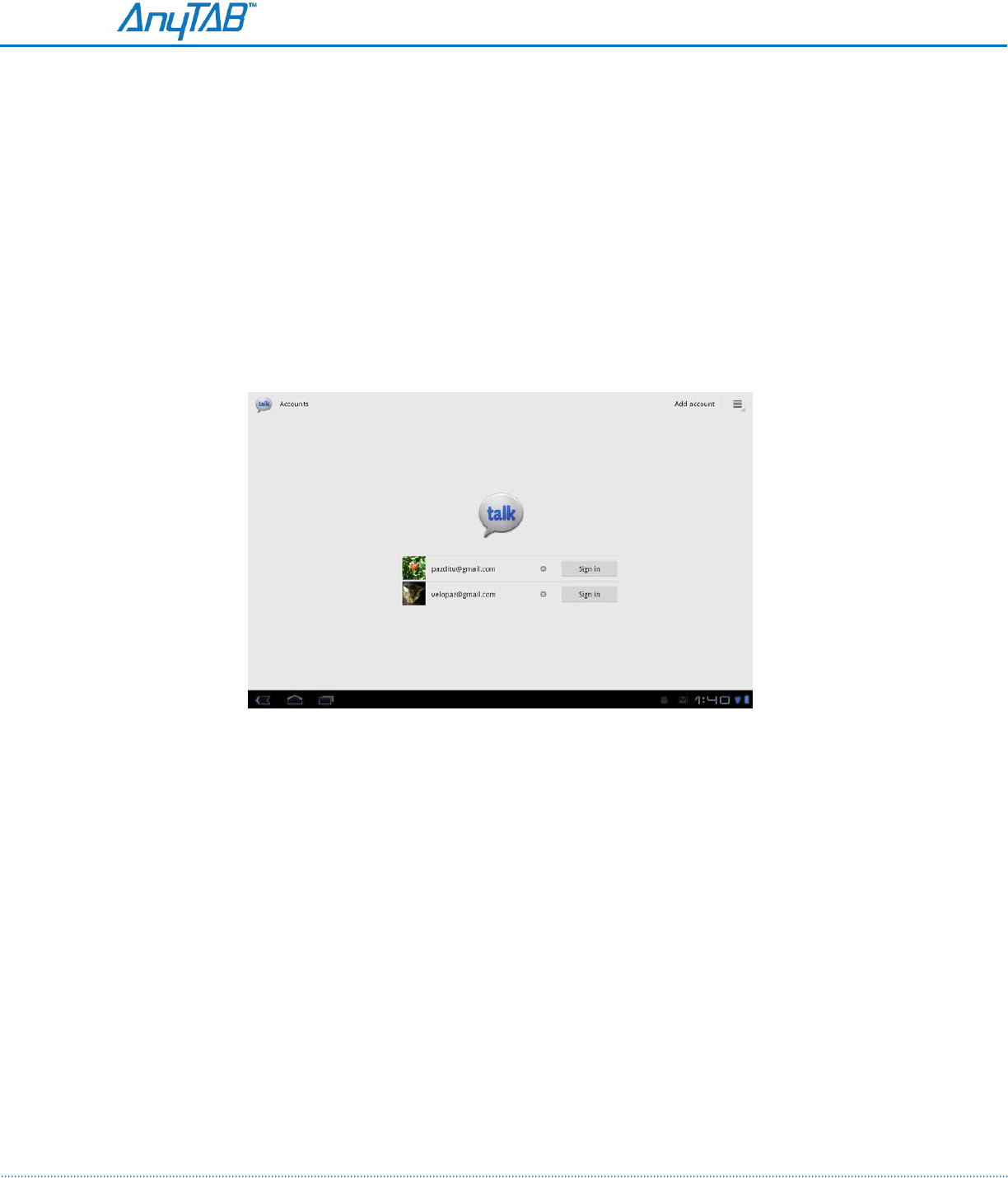
33
Google Talk
Google Talk is Google’s
instant
messaging and audio and video chat service.
Y
o
u
can use it to
communicate
in real time with other people who also use Google
T
a
lk,
on another Android tablet or phone or on a
computer
.
Signing in and opening your Friends list
Touch the Google Talk icon on the Apps screen or a shortcut icon on
a Home screen.
If you are not already signed into Talk, you’re prompted to sign into a Google Account you added to your
tablet.
Y
o
u
remain signed in, even when you’re
using
other
applications,
until you
de
liberate
l
y
sign
out.
Y
o
u
can add a Google Account by touching the Add
account
button at the
top-
right of the Accounts
screen,
to open the Accounts & Sync
settings.
Once you sign into Google Talk, your Friends list is displayed on the left
and
your current
status
and other
information is displayed in the main part of
th
e screen.
Y
o
u
r
Friends list includes all of the friends you’ve
added by
u
s
in
g
Google Talk on the web, on your tablet or other Android device, or with
a
desktop Talk
application.

34
Email
Y
o
u
use the Email
application
to read and send email from services other
than
Gmail. Email
includes
a
wizard that makes it easy to configure it for
several
popular email service providers, including those based
on IMAP and
POP3.
Touch the Email icon on the Apps screen or touch a
shortcut
icon on a
Ho
me
screen.
The first time you open Email, a setup wizard opens to help you add an
email
account.
After the initial
setup,
Email opens to the last screen you were viewing or, if you have not used Email
recently, it displays the
contents
of the Inbox for the
acco
unt
you picked to send email from by
de
fault.
Y
o
u
can also add an Email
account shortcut
to a Home
screen,
so that you
can
open that
account
directly
from that Home
screen.
Each
account
has Inbox, Outbox, Sent, and Drafts folders. Depending on
th
e
features
supported
by your
accoun
t
’
s
service provider, you may have
additi
onal
fo
ld
ers.
- Switch to the
account
you want to work
wi
th.
- The
accounts
folders are listed in the left
co
lumn.
- Touch an account’s
folder
.
- The
messages
in that folder are
displaye
d.
Switching Accounts
If you have more than one email
account,
the current
account
is displayed at
the
top-left in the
Application bar when you are viewing your
mail.
Touch the name of the current account in the Application
bar and then
touch
the
account
whose email you want to view.
Adding and Changing Email accounts
The first time you open Email,
you’re
prompted to set up an email
account.
After that, you can configure
Email to send and receive email from
additional
a
cco
unts.
The
accounts
that you configure are displayed
in the Accounts
screen.
The Email setup wizard helps you set up your
account
for many popular
emai
l
systems,
including those
based on
IMAP
and POP3, so you can read and work with the same email as you do on a computer in
Thunderbird,
Mac Mail, in a
we
b
browser, or with another email
application.
If your service provider
requ
ir
es
additional settings,
or if your service provider is unknown to Email, you can
enter
the necessary
details manually, though you will typically need to
contact
your
e
m
a
il
service provider to
determine
the right
settings
for your
ac
count.
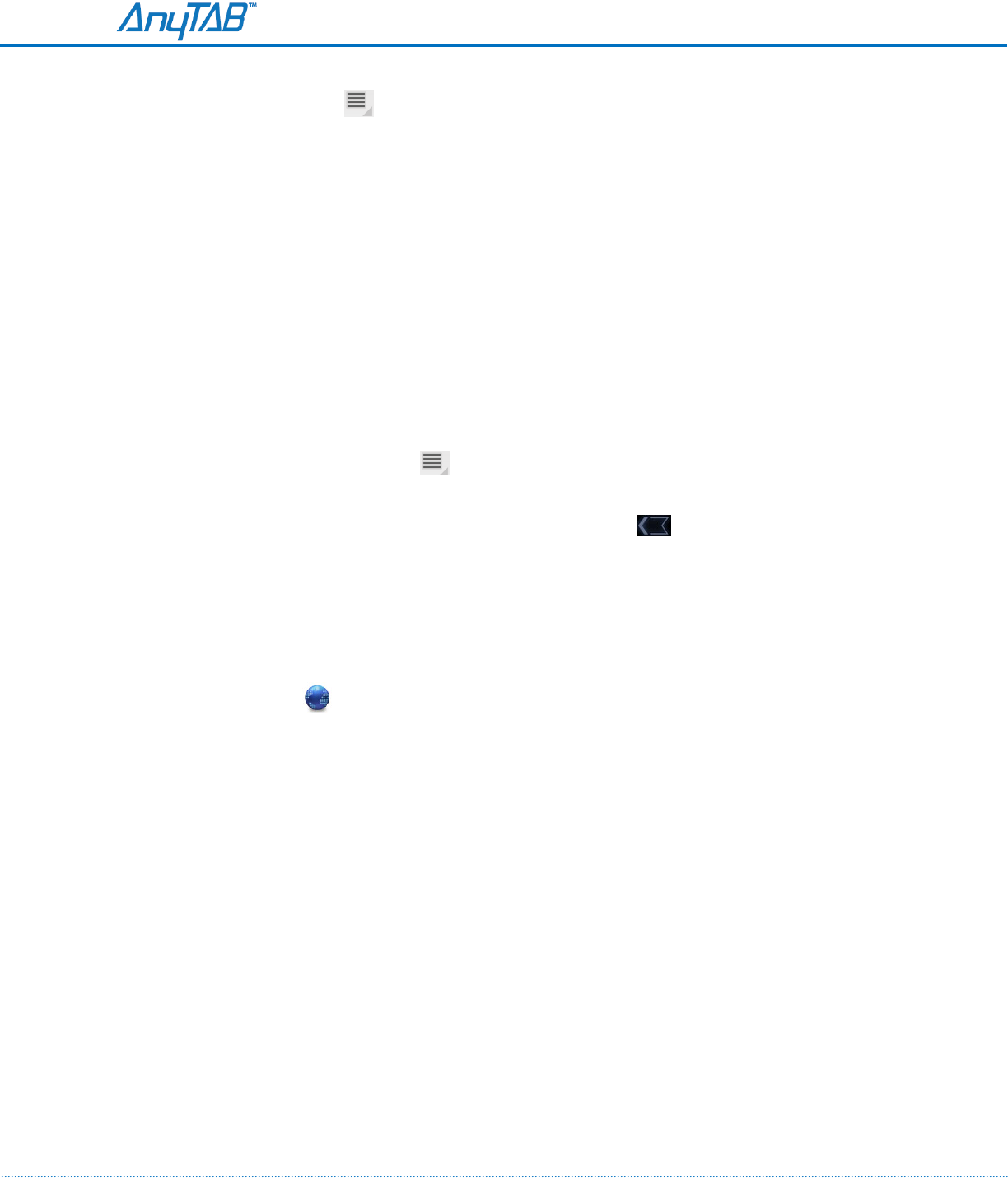
35
Adding an Email Account
- Touch the Menu button in the Applications bar and touch Account Settings.
- Touch Add Account in the Application bar.
- In the Setup Email screen, enter your email address and password.
- Touch Next. Or, if you need to enter email account settings the wizard can’t configure for you touch
Manual setup.
- If you touch Next, Email attempts to communicate with your email service provider to validate your
account for sending and receiving mail, using just your email address and password. This is sufficient
for most email services.
Change an Account’s settings
Y
o
u
can change a number of
settings
for an
account,
including how often you check for email,
how you’re notified of new mail, and details about the servers
th
e
account
uses to send and
receive
mai
l
.
- Touch the Menu button in the Application bar and touch Acc
o
unt
settings
.
- Touch the name of the account whose
settings
you want to
change.
- When you’re finished changing
settings,
touch Back .
Browser
Y
o
u
use Browser to open webpages and to search for information on the
web.
Touch the Browser icon on the Apps screen or touch a shortcut icon on
a Home screen.
Browser also opens when you touch a web link—for example, in an email or
chat.
When you open Browser, the last webpage you were viewing is displayed. If you haven’t used Browser
recently, your homepage
ope
n
s.
The web address (URL) of the current page is displayed at the top of
the
window, unless a site scrolls the
URL bar off the top of the screen; if so,
just
touch the down-arrow in the tab to show it
aga
in
.

36
Maps, Navigation, Places, and Latitude
Y
o
u
use Maps to find your current location; to view real-time traffic
conditions, to
get
detailed directions
by foot, public
transportation,
bicycle, or car; and
to
navigate by using spoken, turn-by-turn driving
instructions
through Google
Maps
Navigation
(Beta).
Y
o
u
can find street
addresses, landmarks,
and places of
business,
and locate
these
points-of-interest
directly on a street map or
satellite
image. In some areas, you
can
view
street-level
imagery of
businesses
and
neighborhoods.
With Google
Latitude,
you can view your friends’ locations on your maps and share
your
location
and other information with
them.
The Maps app also contains three
features
that allow for quick
access
to Google
Places,
Navigation (Beta),
and Latitude; these appear as app icons in
the
Launcher
.
Maps does not have information about every
location.
Camera
Camera is a
combination
camera and
camcorder
that you use to shoot and
share pictures
and
videos.
Pictures
and videos are stored on your tablet’s internal storage.
Y
o
u
can copy your
pictures
and videos to a
computer.
Y
o
u
can view your
pictures
and videos on your
tablet,
edit them, share them,
and
so on with Gallery.
Gallery
Y
o
u
use Gallery to view
pictures
and play videos that you’ve taken with
Camera, downloaded,
or copied to
your
tablet.
Y
o
u
can also view
pictures
in a Picasa
web
album.
Y
o
u
can perform basic editing tasks on
pictures
and set them as your wallpaper or
contact picture.
Y
o
u
can also share your
pictures
and videos
wi
th
friends, via email or
messaging,
or by uploading them to the Picasa and
Y
o
u
T
ube
web
sites.
Movie Studio
Use Movie Studio to edit the videos you take with Camera or copy onto your
tablet
into movies.
Y
o
u
can
cut and order
scenes,
add a sound track, and so
on.

37
Music
Use Music to listen to music and other audio files that you copy from your
computer
or download from the
Internet.
Transferring music files to your tablet
Music plays audio files that are stored on your tablet’s internal storage, so
before
you open Music, you
must copy audio files from your
co
mputer
.
Music supports a wide variety of audio file formats, so it can play music that you
purchase
from online
stores, music that you copy from your CD
collection,
and
so
on.
Music
supports
audio files in
numerous
formats, including MP3, M4A
(i
T
u
ne
s
application
AAC,
DRM-free),
AMR
, MIDI, and
OGG
V
o
rbis.
Copy music files from your computer
1. Connect your tablet to your
comp
ut
er
.
By
default, your
tablet stores music in the Music folder at the root of its file
system.
But
Music will find your music files anywhere you put them on your
t
a
bl
et
,
except the
Ringtones
fol
d
e
r
.
2. Copy music and other audio files from your
computer
to your
t
a
b
l
et
.
Y
o
u
can use
subfolders
to organize your music
fi
les.
3. If the music files have
accompanying
artwork in JPEG format, rename the
art
file
albumart.jpg
and include it in the same folder as the music
fi
les.
4. If you have
created
any playlists, create a subfolder for them in your
mu
sic
folder and
copy the playlists into
it.
5.
Disconnect
your tablet from your
comp
ut
er
.
When you next start Music, it
searches
your
table
t
’
s
storage and adds the
music
to your
libra
ry
.
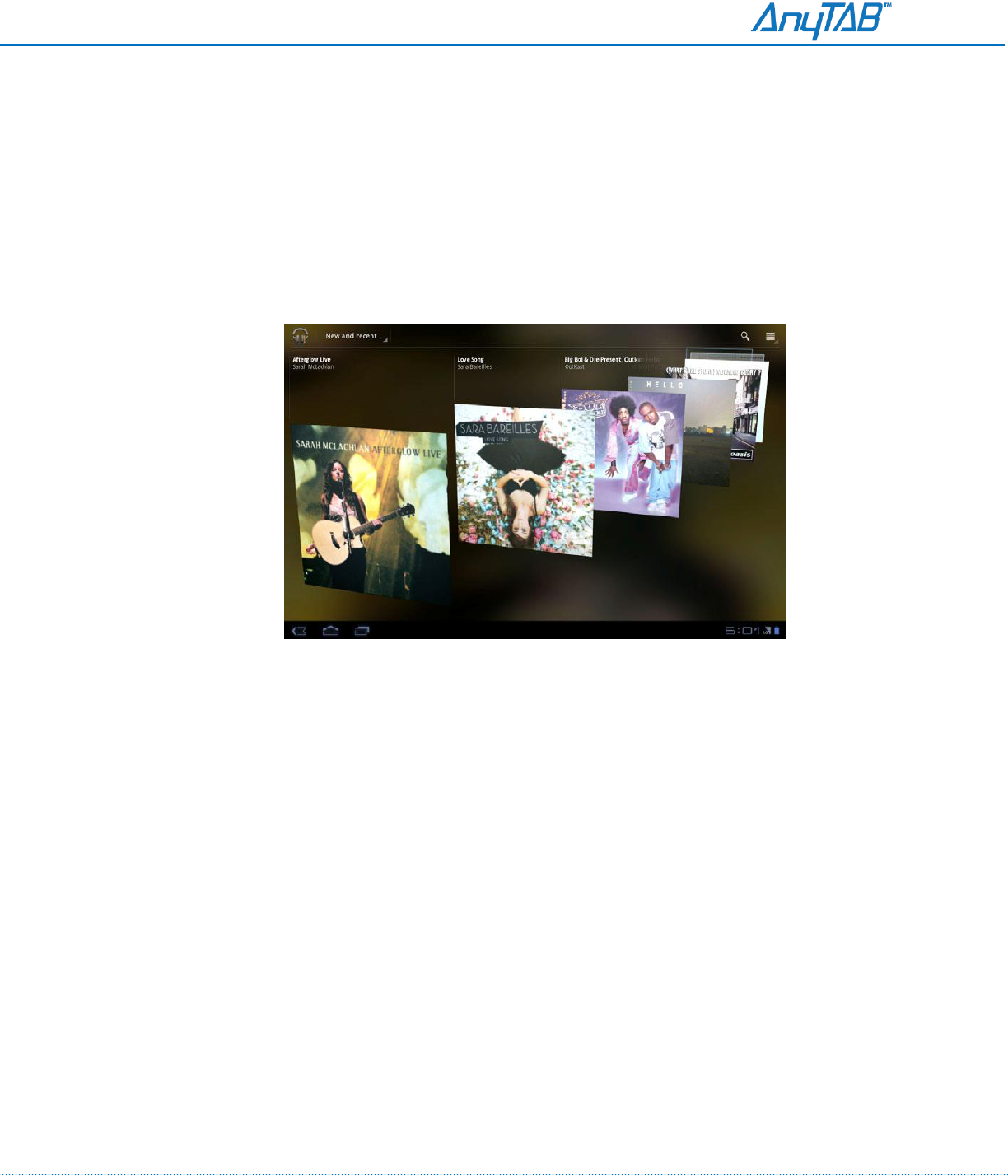
38
Opening Music and working with your library
After you’ve copied some music onto your
table
t
’
s
internal storage
,
or downloaded music from another
source, you can open Music and see your library of music files.
Touch the music icon on the Apps screen, or touch a shortcut icon on a Home screen .
When you copy music to your
tablet,
Music
searches
it for music files
a
nd
builds a catalog of your music,
based on information about each file that
is
stored in the file itself. This can take from a few
seconds
to
several
minutes,
depending
on the number of
fil
e
s.
When the catalog is
complete,
the Music library screen
opens, displaying
a
carousel view of your new and recent music, organized by
album
Swipe left or right to spin the carousel and browse through your new and
r
ece
nt
mu
sic.
Y
o
u
can return to Music’s Library screen from most other
screens
in the
Music
application
by touching the
Music app icon at the top-left of the
Appl
ication bar
.
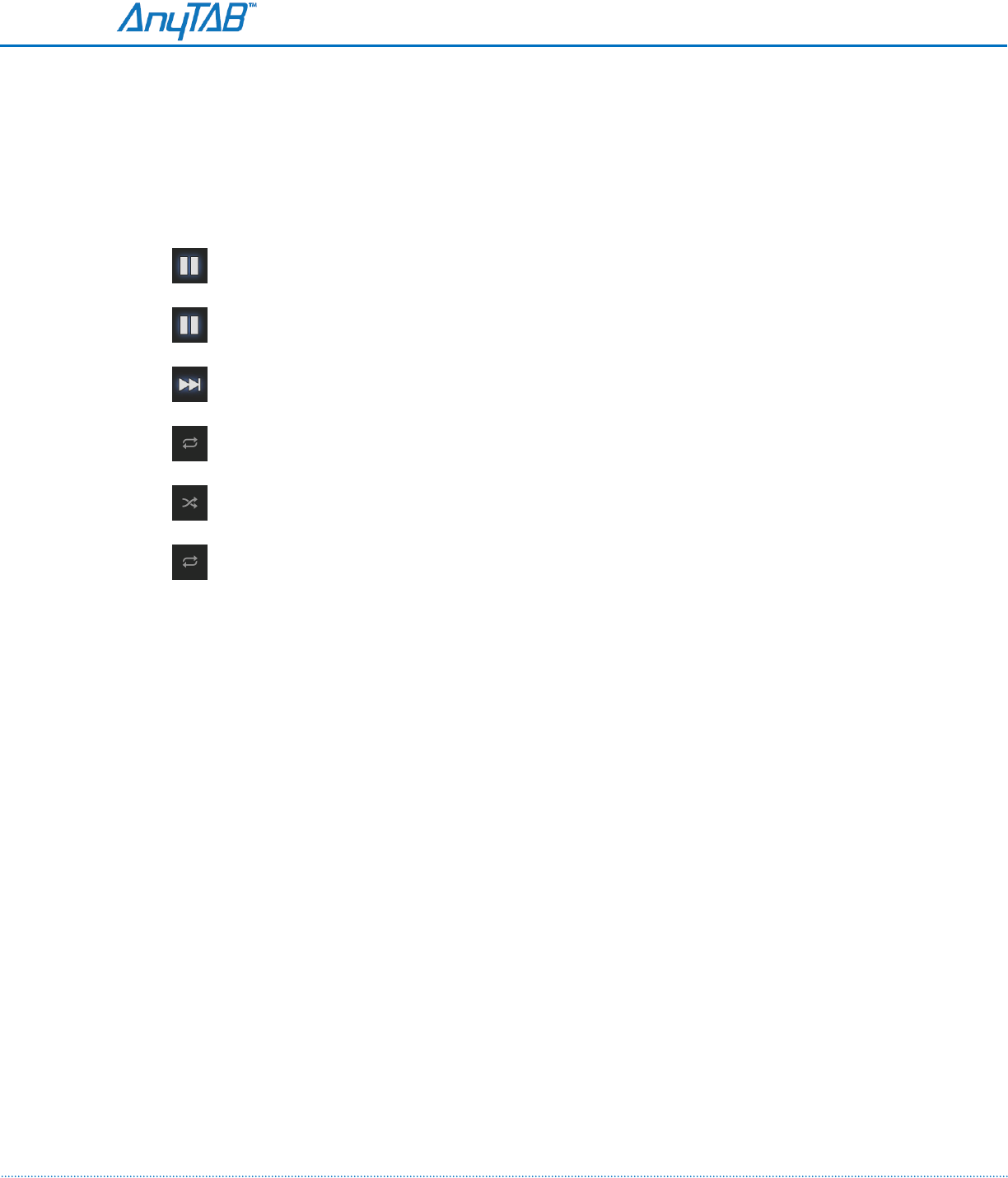
39
Playing Music
Touch a song in your library to listen to it. The Playback screen opens and the song you
touched
or the first
song in
th
e
album or other list starts to play. The tracks in the current list play in order
unti
l
you reach the
end of the playlist (unless you choose a repeat option).
Oth
e
r
w
i
s
e,
playback stops only if you stop it, even
when you switch
applications.
The Playback screen
contains
several icons that you can touch to control
th
e
playback of songs,
albums,
and playl
i
sts:
Touch to pause playback
Touch to resume playback
Touch to skip to the next track in the album, playlist, or
shuffle.
Touch to skip to the previous track in the album, playlist, or
shuffle
.
Touch to play the current playlist in shuffle mode (tracks
are
played in random
or
der)
.
Touch to toggle repeat mode: Don’t
repeat,
repeat the
c
u
rr
en
t
list, or repeat the
current
track
.
Books
Use the Books app to read eBooks from the web-based Google Books service.
Y
o
u
can read books online
or mark them for availability offline, so you can read
them
when you don’t have an
Internet connection
(such as on an
airplane).
Y
o
u
can
also
use Books as your starting point for browsing or
searching
for books
on
line.

40
Clock
The Clock
application
displays the date and time.
Y
o
u
can also use it to turn your tablet into an alarm
clock.
Touch the clock icon on the Apps screen or touch a
shortcut
icon on a
Ho
me
screen.
Clock opens displaying the date and time, along with date and time of the
next
scheduled
al
arm
.
If Clock is open when your screen darkens, it reopens when you wake
the
phone,
instead
of the lock
screen.
If you have
secured
your lock
screen,
t
o
uc
h
Back to open the lock screen so you can unlock
your
tablet.
Setting and changing alarms
The Clock
application
displays the date and time.
Y
o
u
can also use it to turn your tablet into an alarm
clock.
1. Touch Set alarm or Alarm
set
(if you have an alarm already set) on the Clock
screen.
2.
Touch Add
al
arm
.
3.
Use the up and down arrows to set the
time. Then
touch
Set
.
A dialog with details about the alarm
opens.
4.
Touch
Repeat
to open a dialog where you can check the days on which you want the
alarm to
soun
d.
5.
Touch
Ringtone
to select a ringtone for the
a
l
ar
m.
The ringtone plays briefly when you select
i
t
.
6.
Touch Label to open a dialog where you can type a label for the
ala
r
m.
7.
Touch
Don
e
.
Calculator
Use Calculator to solve simple
arithmetic
problems or use its
advanced
operators
to
solve more complex
equations.
Touch the Calculator icon on the Apps screen or touch a shortcut icon on
a
Home
sc
ree
n
.
Enter
numbers
or operators to figure
arithmetic
and trigonometric
probl
ems,
just as on a pocket
calculator.
Touch & hold the
Calcu
l
ator
’
s
display to copy the
contents
of the display, so you can paste it into a text field
in another
app.

41
Market
Android Market provides direct
access
to free and paid
applications,
games,
and
books that you can
download and install on your
tablet.
Settings
Y
o
u
use the
Settings application
to configure how your tablet looks,
sounds, communicates, protects
your privacy, and operates in many other ways.
Many
applications
also have their own
settings;
for
details,
see the
documentati
o
n
for those
applicati
o
ns.
Opening Settings
The Clock
application
displays the date and time.
Y
o
u
can also use it to turn your tablet into an alarm
clock.
Touch the time in the lower-right of the System bar to open the
Status
De
tai
l
s,
touch in the
Status
Details
to open Quick
Settings,
and then touch
Settings
.
OR Touch the Settings icon on the Apps screen or touch a shortcut icon on a
Home
screen.
Wireless & networks
settings
Use Wireless & Network settings to configure and manage
connections
to
ne
twor
ks
and devices via Wi-Fi,
Bluetooth, mobile networks, and via a USB
connection.
Y
o
u
also use Wireless & Network
settings
to
configure
connections
between your
table
t
and virtual private networks (VPNs), to
connect
other devices to
the
Internet using
your
t
a
b
l
et
’
s
mobile data
connection,
and to turn off all radios with Airplane
m
o
d
e
.
- Airplane Mode: Check to turn off all the tablet’s radios that transmit data.
- Wi-Fi: Check to turn on Wi-Fi so you can connect to Wi-Fi networks.
- Bluetooth: Check to turn on Bluetooth so you can connect to Bluetooth devices
- VPN setting

42
Wi-Fi settings screen
Wi-Fi: Check to turn on Wi-Fi so you can
connect
to Wi-Fi networks. When
connected
to a
network, displays the network’s
na
me
.
Network
notification:
Check to receive a notification in the System bar when
an
open Wi-Fi
network becomes
a
v
ail
able.
WiFi disconnect policy: opens a dialogue where you can set when you want
to
disconnect
from Wi-Fi
networks and
connect
to mobile data networks: when
the
screen turns off (uses more mobile
data), never when plugged in, or never
(u
ses
more battery power)
.
Wi-Fi networks: Displays a list of Wi-Fi networks you’ve previously
conf
igu
r
ed
and those
detected
when the tablet last
scanned
for Wi-Fi networks.
Add Wi-Fi network: Opens a dialog where you can add a Wi-Fi network by entering its SSID (the
name it
broadcasts),
security type, and other
properties.
Bluetooth settings screen
Bluetooth: Check to turn on Bluetooth so you can
connect
to Bluetooth devi
ces.
Device name: Opens a dialog where you can give your tablet a name that
i
s
visible on some
Bluetooth devices. The current name is
di
spl
a
yed
.
Discoverable: Check to make your tablet discoverable by other Bluetooth
de
vices
for
120
sec
o
nd
s.
Bluetooth devices: Displays a list of Bluetooth devices that you’ve previ
o
usly configured and those
detected
when the tablet last
scanned
for Bluetooth devi
ces.
Find nearby devices: Touch to search for and display information about
ne
arby
Bluetooth devi
ces.
VPN settings screen
Add VPN: Opens a screen that prompts you to select the type of VPN to add.
Y
o
u
are then
prompted
for VPN configuration
d
e
t
a
ils.
VPNs: The list of
V
P
Ns
that you’ve previously
c
o
nf
ig
ur
ed
.

43
Sounds settings screen
Use the Sound
settings
to configure how, and at what volume, the tablet
pla
ys
music or other media with
audio, notification
ringtones,
and alarms.
Y
o
u
also
use
these
settings
to pick the notification ringtone you
prefer and whether you
hear
audible feedback when touching or locking and unlocking the
sc
ree
n
.
Volume: Opens a dialog with three sliders for
adjusting
the volume of music
and
other media
audio, notification
ringtones,
and
alarms.
Notification ringtone: Opens a dialog where you can select the ringtone to
so
und
when you
receive a
notification.
Touch a ringtone to listen to
i
t
.
Audible
selection:
Check to play a sound when you touch
buttons,
icons,
and
other
onscreen
i
t
e
m
s.
Screen lock sounds: Check to play a sound when the screen is locked or
unlo
cke
d.
Screen settings
Use the Screen
settings
to configure
brightness
and other screen
settings.
Brightness: Opens a dialog for
adjusting
the
brightness
of the
screen.
Y
o
u
can
check
A
u
tomatic
brightness
to set the tablet to adjust the
b
rig
ht
n
e
ss
au
to
ma
tic
a
ll
y
,
using the tablet’s built-in light
sensor. Or
uncheck
that option to
use
the slider to set a
brightness
level you want at all times
when using the
tablet.
For the longest battery life between charges, use the dimmest comfortable
bright
ness.
Auto-rotate screen: Check to
automatically
switch the orientation of the
scre
en
as you turn the
tablet sideways or
up
ri
gh
t.
Animation: Opens a dialog where you can set whether you want to enjoy
a
n
i
m
a
t
e
d
transitions
for
some effects (such as opening
menus),
for all
supported
ef
f
ec
t
s
(including when navigating from
screen to
screen),
or to enjoy a tablet without
an
y
optional
animation
effects (this setting does
not control animation in
all
ap
pl
ica
t
io
ns)
.
Screen timeout: Opens a dialog where you can set how long to wait after you touch the screen
or press a button before the screen
darkens.
For the
lo
ngest
battery life between charges, use
the
shortest
convenient
timeo
u
t.
Location and Security settings
Use the Location & Security settings to configure how you want the tablet
t
o
determine
your location (this
affects accuracy) and how you want to share your location with Google and others.
Y
o
u
can also configure
settings
that help
sec
u
re
your tablet and its
data.
Use wireless networks: Check to use information from Wi-Fi
networks
to
determine
your
approximate location, for use in Maps and
other
geographically aware
applications,
when you
search,
and so on. When you
check
this option, you’re asked whether you
consent
to sharing your
location
anonymously
with Google’s location service, to help improve the
se
rvi
ce.
Use GPS
satellites:
Check to use your tablet’s global positioning system (GPS)
satellite
receiver to
pinpoint your location to within accuracy as close as
se
vera
l
meters
(“street
level”). Actual GPS
accuracy
depends
on a clear view of the sky
and
other
factors.

44
Use location for Google Search: Check to use include information about your location when you
use Google Search,
V
o
ice
Search, and so
o
n
.
Configure lock screen: Touch to configure your lock screen to require a
pa
ttern,
PIN, or password
to unlock your
screen,
or never to show the lock screen at all.
Owner info: Opens a screen where you can set whether you want to
display
information about
yourself (such as your
contact
information) on the lock
sc
re
en
and where you can enter the text
you want to
display
.
Encrypt tablet: Touch to encrypt the
contents
of your tablet and to require
a
numeric PIN or
password to decrypt your tablet each time you power it on
.
Set up SIM card lock: (Only for
tablets
that use a SIM card.) Opens a
scre
en
where you can
configure the tablet to require entering the SIM PIN to use
th
e tablet,
and where you can
change the SIM
PIN.
Visible passwords
: Check to briefly show each character of passwords as you enter them so that
you can see what you enter.
Device
administrators:
Opens a screen with a list of the
applications
you
have
authorized to be
administrators
for your
tablet.
This is typically an email,
ca
le
ndar
,
or other
enterprise application
that you granted this authority to, when you
a
d
ded
an account hosted by an
enterprise
service
that requires the ability to
impl
ement
security policies on any devices that
connect
to it. Touch an
application
in this
list
to disable its authority to be a device
administrator;
if you do, the
account
you added will typically lose some functionality in its
applications,
such as the
abili
ty
to sync new
email or
calendar
events, until you restore the
application’s authority
as a device
administrator.
Applications whose device
administration
authority you disable in this way, but that have
accounts
that require them to be a devi
ce
administrators,
typically notify you how to restore their
authority when you try
t
o
use them, unless you delete those
accounts.
Use secure
credentials:
Check to allow
applications
to
access
your
tablet’
s
encrypted
store of
secure
certificates
and related passwords and other
cre
dential
s.
Y
o
u
use
credential
storage to
establish
some kinds of VPN and Wi-Fi
con
n
ecti
o
ns,
as
described
in
“Connecting
to networks and
devices” on page 57. If you have
n
o
t
set a password for the
credential
storage, this setting is
di
mme
d
.
Install from storage: Touch to install a secure
certificate
from your
tabl
et’
s
storage, as
described
in “Working with secure
certificates”
on page
81.
Set password: Opens a dialog where you can set or change the password for your secure
credential
storage.
Y
o
ur
password must have at least 8
characters. See
“Working with secure
certificates”
on page
81.
Clear storage: Deletes all secure
certificates
and related
credentials
and
erases
the
credential
storage’s own password, after prompting you to confirm that you want to do
this.

45
Applications settings
Y
o
u
use the Applications
settings
to view details about the
applications
in
sta
l
le
d
on your
tablet,
to manage
their data, to force them to stop if they
misbehave,
a
nd
to set whether you want to permit
installation
of
applications
that you obtain
fro
m
web sites and
emai
l.
Running services: Opens a list of
applications, processes,
and services,
service
s
that are currently
running or are
cached.
Storage use: Opens a list of all
applications
on your tablet with information
ab
ou
t
the storage
they use.
Battery use: Opens a list of the
applications
that have used battery power
s
i
n
ce
you last
charged your
tablet.
Unknown sources: Check to permit
installation
of
applications
that you
obtai
n
from web sites,
email, or other locations other than Android
Market.
Warning!
To protect your tablet and personal data, download
applications
only from trusted
sources,
such as Android
Mark
et.
Manage
applications
Opens a list of all the
applications
and other
software
installed
on
your
tablet,
along with their sizes and tools for managing them.
Account and synch settings
Use the Accounts & Sync
settings
to add, remove, and manage your Google Accounts and other
accounts.
Y
o
u
also use these
settings
to control how
and
whether
applications
send, receive, and sync data on their
own
schedules, and
whether
applications
can synchronize user data
aut
o
matical
l
y
.
Gmail, Calendar, and other
applications
may also have their own
settings
to
control
how they synchronize
data; see the
documentation
for those
applications
for
d
e
ta
ils.
Background data: Check to permit
applications
to synchronize data in
th
e
background,
whether or
not you are actively working in them. Unchecking
this
setting can save battery power and lowers
(but does not
eliminate)
data
use.
Auto-sync: Check to permit
applications
to synchronize data on their own
schedule.
If you uncheck
this
setting,
you must touch an
account
in the list on
this
screen and touch to synchronize data
for that
account.
Synchronizing
da
ta
au
to
ma
tic
a
ll
y
is
disabled
if
Background
data is
unchecked.
In that case,
Au
t
o
-
sync is
d
i
mm
ed
.
Manage
accounts
The rest of this screen lists the Google Accounts and
other
accounts
you’ve
added to the
tablet.

46
Privacy settings
Y
o
u
use the Privacy
settings
to manage whether your
settings
and other data
are
backed up to Google
servers, using your Google
account.
Y
o
u
also use
thes
e
settings
to erase all the data on your tablet by
performing a factory data
rese
t.
Back up my data: Check to back up some of your personal data to Google
servers,
with your
Google Account. If you replace your
tablet,
you can restore
the
data you’ve backed up, the first
time you sign in with your Google Account. If you check this option, a wide variety of your personal
data is backed up, including your Wi-Fi
passwords,
Browser bookmarks, a list of the
applications
you’ve
instal
led
from Market, the words you’ve added to the user dictionary used by the
onscreen
keyboard, and most of the
settings
that you configure with the Settings
appli
cation.
Some third-
party
applications
may also take advantage of this
feature,
so you
ca
n
restore your data if you
reinstall an
application.
If you
uncheck
this option, you
stop
backing up your data to your
account,
and any existing backups are
de
let
e
d
from Google
servers.
Backup
account:
Displays the Google Account that your
settings
and other
da
ta
are backed up
with. This is the
account
you need to sign into on a new
Androi
d
tablet or other device, if you
want to restore the
settings
from this tablet to
t
h
at
device
.
Automatic restore: Check this option to restore
settings
and other data when you reinstall an
application.
This feature requires that you are backing up your
data
with your Google Account and
that the
application
is using the backup servi
ce.
Factory data reset: Opens a dialog where you can erase all of your personal
da
ta
from internal
tablet storage, including information about your Google Account,
any
other
accounts,
your system
and
application settings,
any
downloaded
applica
t
io
ns,
as well as your music, photos, videos, and
other files. If you reset
the
tablet in this way, the next time you turn on your tablet
you’re
prompted to
re
en
ter
the same kind of information as when you first
started
Android.
Storage settings
Use the Storage
settings
to monitor the used and available space on your
tablet’
s
internal
storage.
Y
o
u
can also view and manage the storage used by
applications.
Y
o
u
can view, reopen, and delete files
you’ve downloaded with Browser, Gmail, or Email with the Downloads
application.

47
Language and input settings
Use the Language & Input
settings
to select the language you want to work with
on
your
tabl
et.
Y
o
u
can also configure the Android voice input
feature
and the
text-to-speech synthesizer,
for
applications
that
can take advantage of it, such as TalkBack.
Y
o
u
can configure the
onscreen
keyboard or other input
methods.
Y
o
u
can also
a
dd
or remove words you’ve
added to the user
dictionary
.
Select language: Opens the Language
screen,
where you can select the
language
to use for the
text on your
tabl
et.
User dictionary: Opens a list of the words you’ve added to the dictionary,
as
described
in “Using
the
onscreen
keyboard” on page 48. Touch a word to edit
i
t
.
Touch the red
X
next to a word to
delete it. Touch the Plus button at the top-right of the Application bar to add a word.
V
o
ice
recognizer
settings:
See “Google
V
oi
ce
Recognition
settings
screen”.
Text-to-speech settings:
See
“T
e
x
t-to-Spe
ech
settings
screen”.
Current input method: Opens a dialog where you can select the input
metho
d
you want to use,
if you have more than one
installed,
or touch
Configure
in
put
methods
to open the screen
where you can configure the current input
meth
od.
Y
o
u
can download alternative keyboards and
other input methods from
A
ndr
oid
Mark
et.
Input method selector: Opens a dialog where can set whether you want
the
Input Selector button to appear in the System bar, to the left of the
t
i
m
e
.
Google voice recognition settings screen
Language: Opens a screen where you can set the language you use when
ente
ring
text by
speak
ing
SafeSearch:
Opens a dialog where you can set whether you want Google
SafeSearch
filtering to
block some results when you use Google
V
o
ice
Se
arc
h:
Block no search results (off), only explicit or
offensive images
(moderate),
or
both
explicit or offensive text and images
(
s
tr
ict
)
.
Block offensive words: When
unchecked,
Google voice recognition will
rec
ognize
and
transcribe
words many people consider offensive, when you enter text by
speaking.
When
checked,
Google
voice recognition
replaces
those words
in
transcriptions
with a
placeholder comprised
of hash
symbols ( #
).
Personalized
recognition: Check if you want Google to store and use
re
c
or
d
i
n
g
s
of what you speak
when using
V
o
ic
e
Search and when entering text by
speaking, to
improve voice recognition for your
own voice. Touch More
information
in
t
h
e
dialog that opens to learn
mo
re
.
Google Account
dashboard:
Touch to open your Google Account
dashboard
i
n
Browser, where you
can view and manage information stored on Google servers
th
at
is
associated
with your Google
Account.

48
Text-to-speech settings screen
Speech rate: Opens a dialog where you can select how fast you want the synthesizer to speak
Listen to an example: Plays a brief sample of the speech
synthesizer,
using your current
settings.
Always use my
settings:
Check to use the
settings
on this screen in place of
speech
synthesizer settings
available in other
applica
t
io
ns.
Default engine: Opens a dialog where you can set the
text-to-speech
a
p
plic
ati
o
n
you want to use,
if you have more than one
instal
led.
Install voice data: If your tablet does not have
speech
synthesizer data
installe
d,
connects
to
Android Market and guides you through the process of
dow
n
l
oading
an
d
installing the data. This
setting is not available if the data is already
instal
led.
Language: Opens a dialog where you can select the language of the text you
w
a
nt
the synthesizer
to read. This is particularly useful in
combination
with the Always Use My Settings setting, to
ensure that text is spoken correctly in a variety of
ap
pl
ica
t
io
ns.
Engines: Lists the
text-to-speech
engines installed on your
tablet.
Touch one
to
view or change
its
settings.
Android keyboard settings
The Android Keyboard
settings
apply to the
onscreen
keyboard that is
in
clu
d
e
d
with your
tablet.
The correction and
capitalization features
affect only the Engli
s
h
version of the
k
e
yboard.
Auto-capitalization:
Check to have the
onscreen
keyboard
au
to
ma
tic
a
ll
y
capitalize
the first
letter of the first word after a period, the first word in a
t
e
xt
field, and each word in name
fi
elds.
Sound on keypress: Check to play a brief sound each time you touch a key
o
n
the
onscreen
keyboard.
Auto-correction: Check to
automatically
enter a
suggested
word, highlighted
i
n
the strip above
the keyboard, when you enter a space or
punctuation.
Show correction
suggestions:
Check to show
suggested
words in a strip
a
b
ove
the
onscreen
keyboard as you type.

49
Accessibility settings
Y
o
u
use the Accessibility
settings
to configure any
accessibility
plug-ins you
have
installed
on your
ta
ble
t
.
Accessibility: Check to enable all
installed accessibility
plug
-i
ns.
KickBack: Check to have the tablet vibrate briefly as feedback as you navi
gate
the user
interface,
touch
buttons,
and so on. This setting is only
included
if your tablet has a vibration
feature.
TalkBack: Check to have an
installed speech
synthesizer speak the labels or names of items
as you navigate the tablet’s user
interfa
ce.
SoundBack:
Check to play a sound as you navigate the tablet’s user
i
nterfac
e.
Accessibility scripts: Check to allow
applications
to download
acce
ssib
ility
scripts from
Goog
le.
Date and Time settings
Use Date & Time settings to set your
preferences
for how dates are displayed.
Y
o
u
can also use these
settings
to set your own time and time zone, rather
th
an
obtaining the current time from the mobile
ne
twor
k.
Automatic date & time: Uncheck to set the date and time on the
ta
ble
t
manually, rather
than obtaining the current time from the mobile
network.
Automatic time zone: Uncheck to set the time zone on the tablet
manuall
y
,
rather than
obtaining the local time zone from the mobile
network.
Set date: If
Automatic date
&
time
is
unchecked,
opens a dialog where you can manually set
the
table
t
’
s
date.
Set time: If
Automatic
is
unchecked,
opens a dialog where you can set
the
t
a
b
l
et
’
s
time.
Select time zone: If
Automatic time zone
is
unchecked,
opens a
di
alog where you can set
the tablet’s time
zone.
Use
24-hour
format: Check to display the time using
24-hour
time
fo
rmat—for
example,
13:00
rather than
1:00 pm.
Select date format: Opens a dialog where you can select the format for displaying
dat
e
s.

50
About Tablet
About tablet includes information about your
table
t
.
System
updates:
Opens a screen that reports on the availability of
Androi
d
system software
updates.
Status:
Opens the
Status
screen with information about your battery,
mo
bi
le
network
connection,
and other
de
ta
il
s.
Battery use: Opens a list of the
applications
and operating system
components
you have used
since you last charged the
tablet,
sorted by the amount of
pow
e
r
they have used.
Legal information: Opens a screen where you can obtain legal information
about
the software
included
with your
tablet.
V
e
rsion
information: Lists details about the model numbers and versions of your tablet’s
hardware and operating system software. This information is useful if you need to work with your
carrie
r
’
s
support
te
am.

51